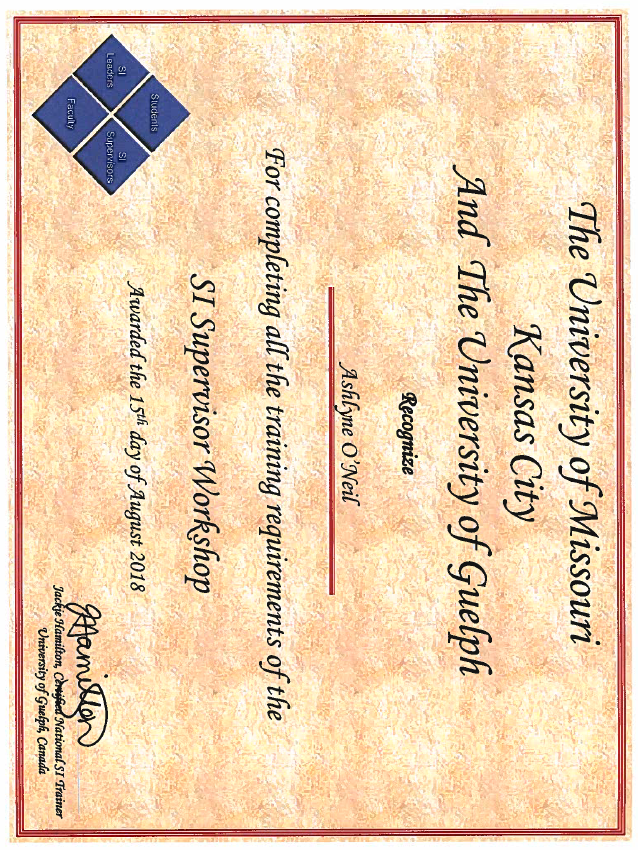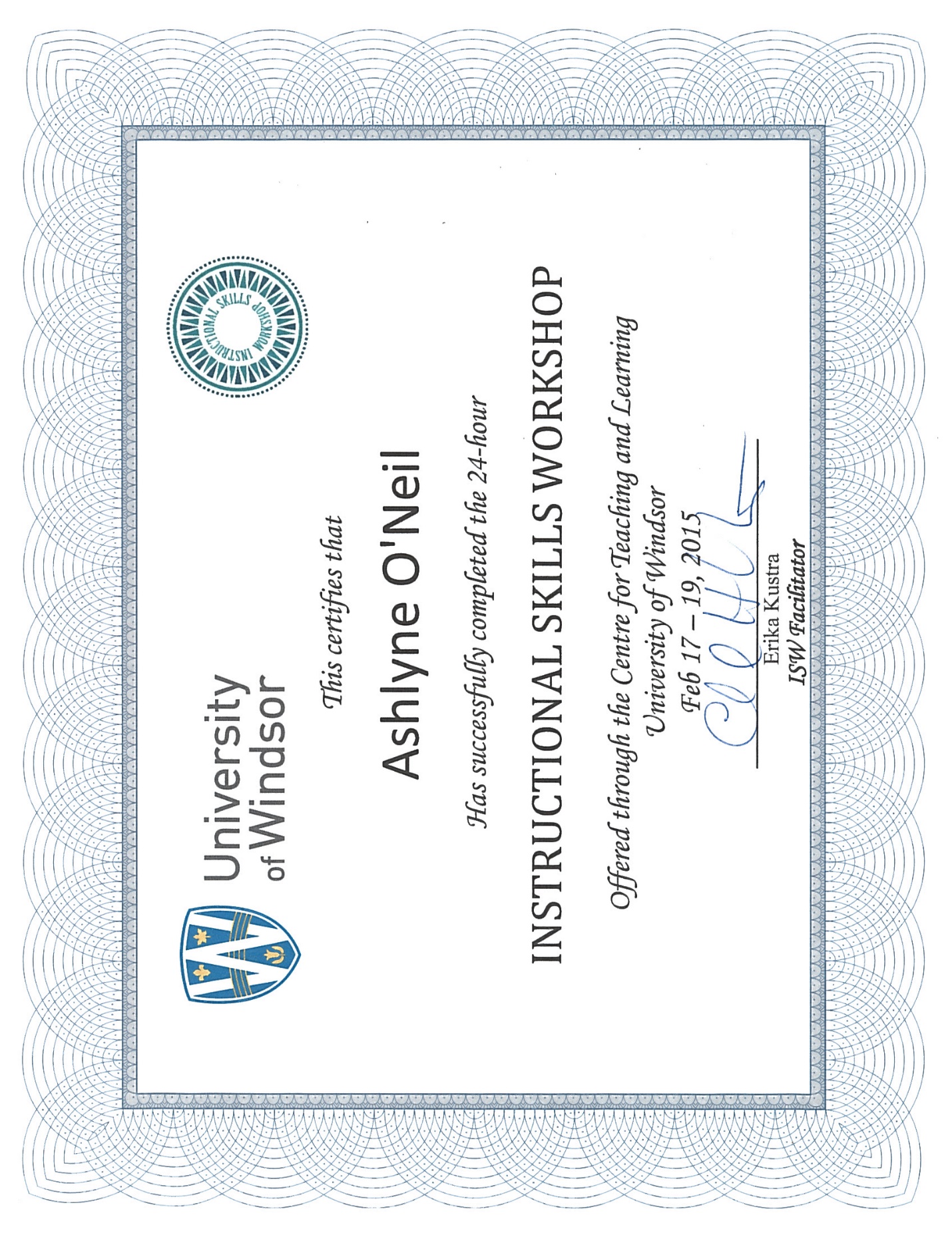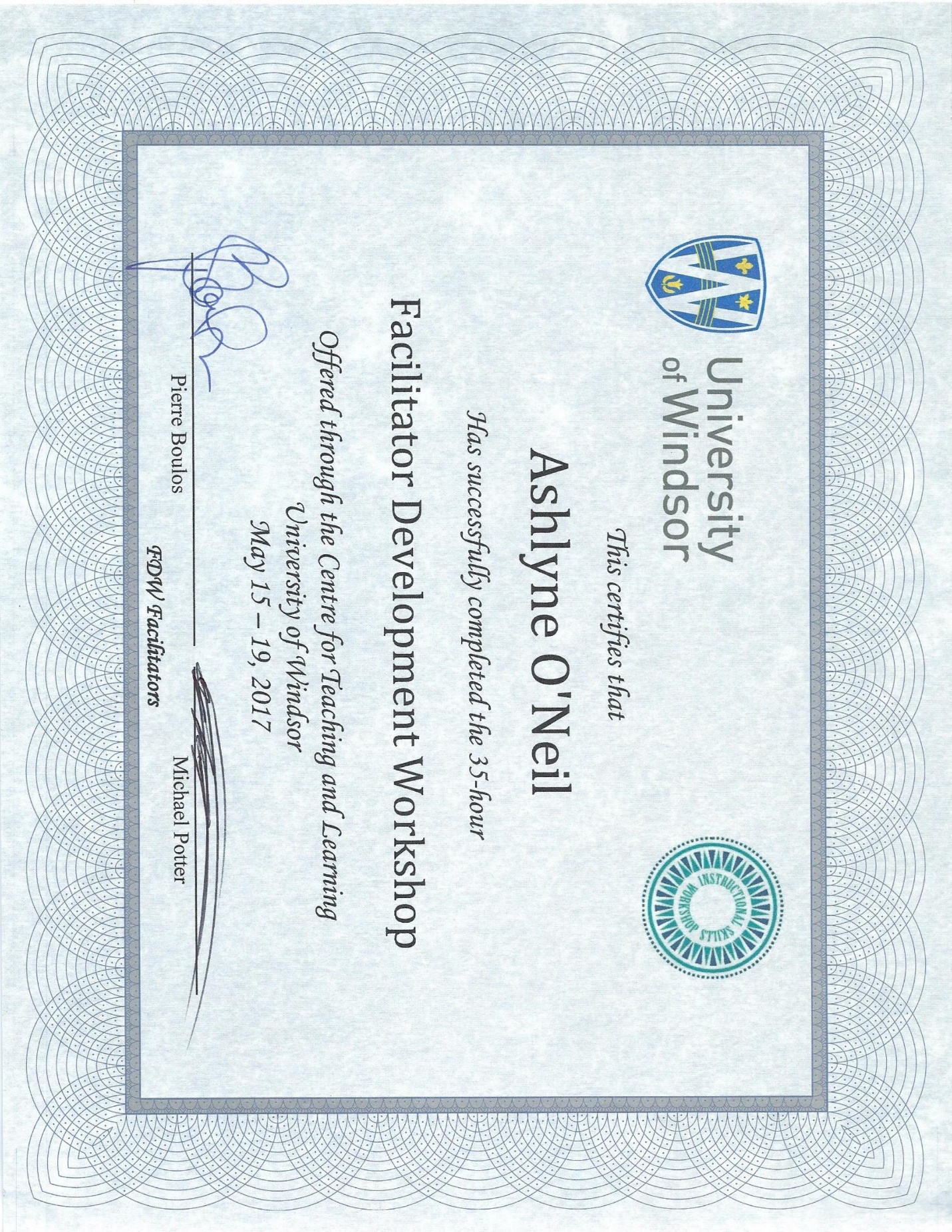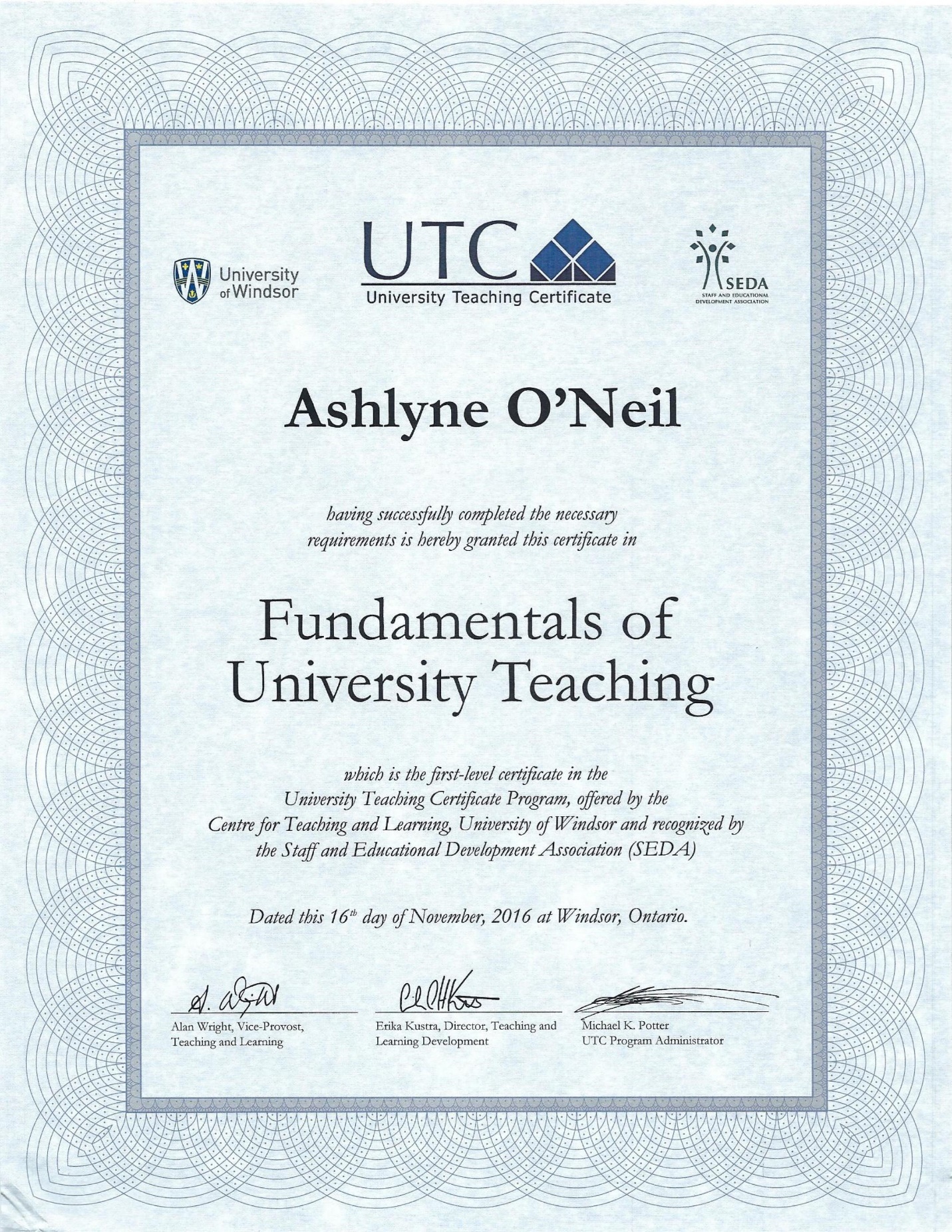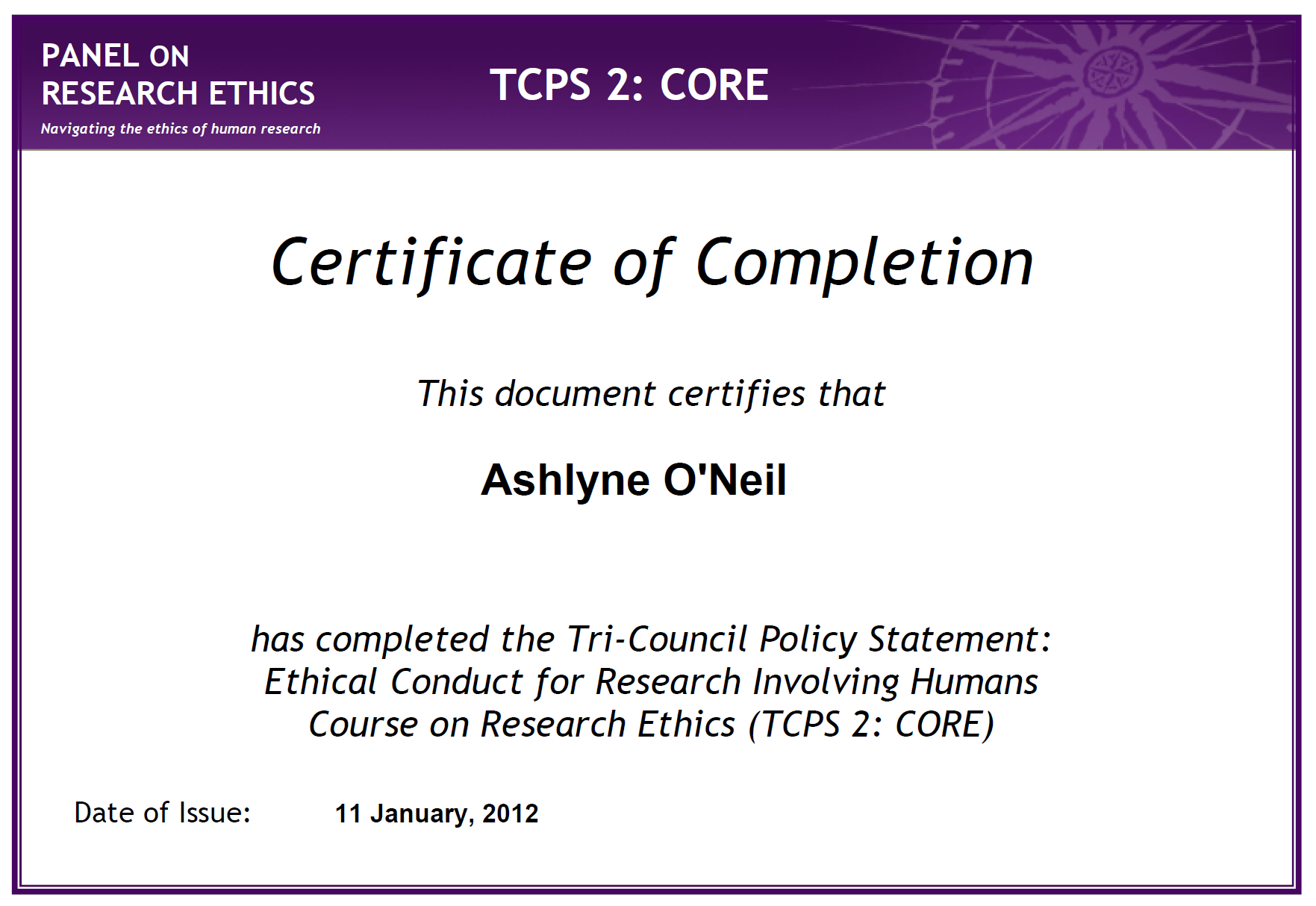7 Appendices
Appendix A: Concept Map of Teaching & ED Philosophy
 While I would not normally include such a rough sketch in a dossier, I wanted to illustrate my thoughts about my philosophy in a visual way.
While I would not normally include such a rough sketch in a dossier, I wanted to illustrate my thoughts about my philosophy in a visual way.
Appendix B: Student Evaluations of Teaching
SETs for Effective Writing
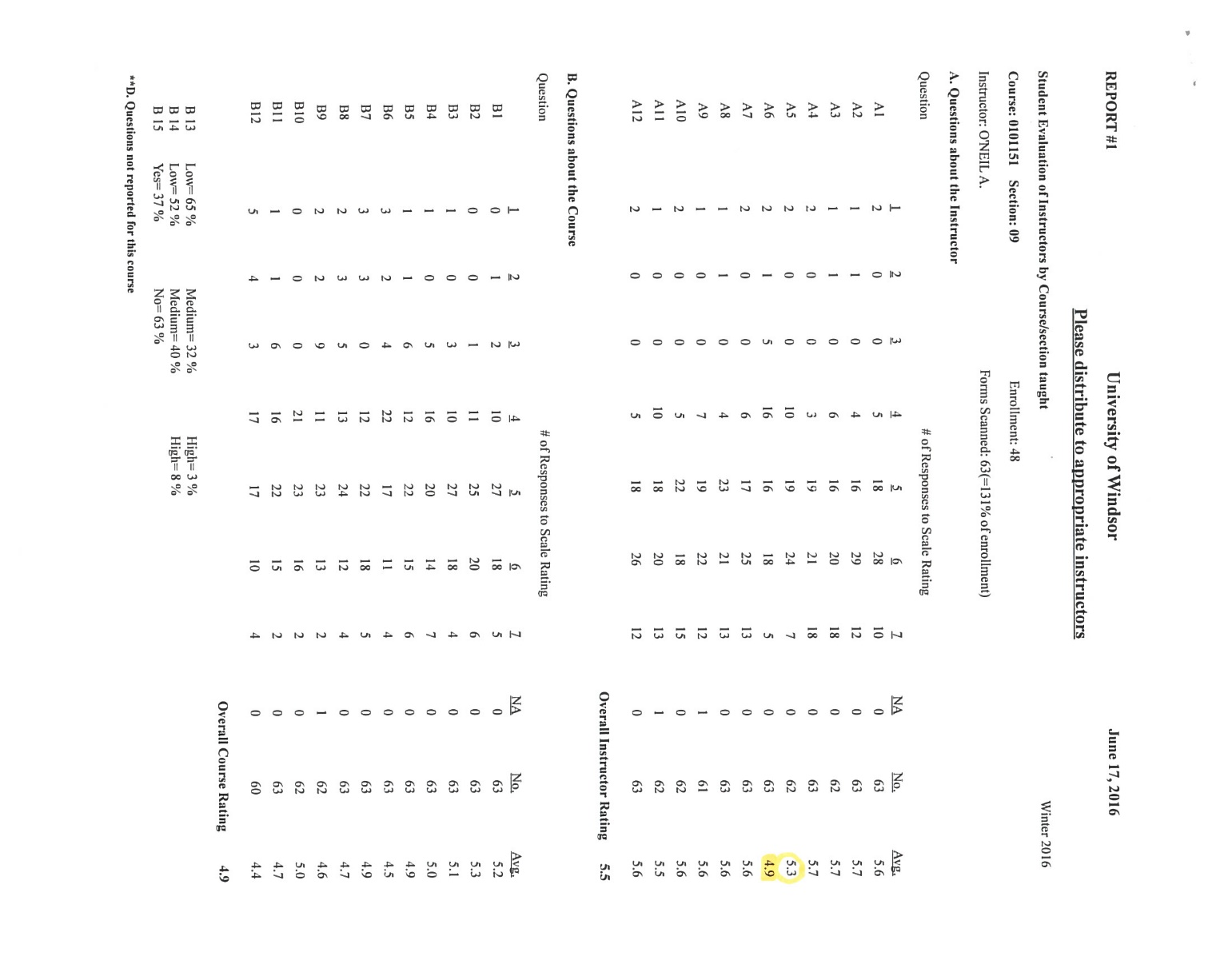
SETs for Introduction to Psychology as a Behavioural Science

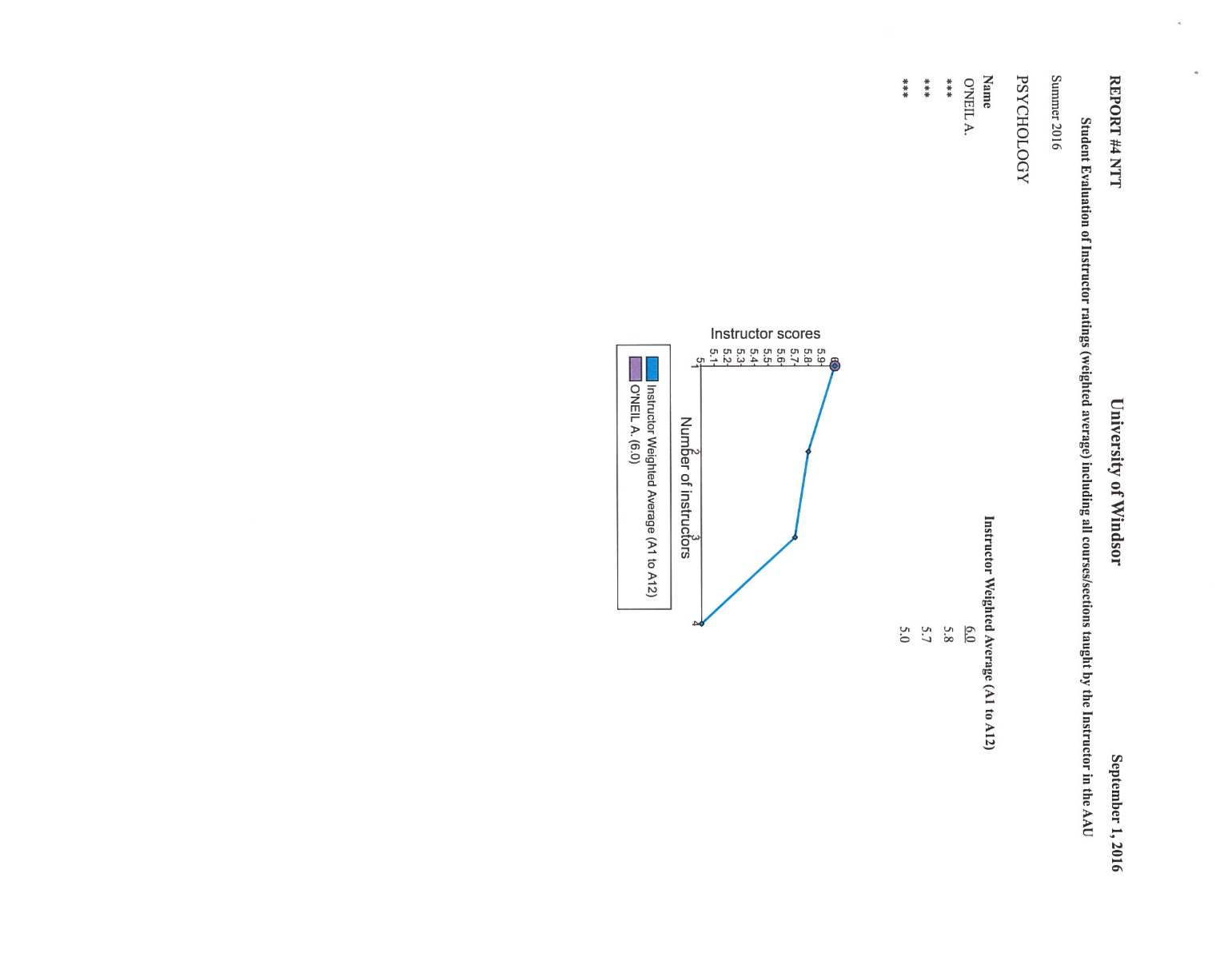



Appendix C: Sample Course Syllabi
Appendix D: Sample Lesson Plan
The topic of the day was conscientiousness, and I was using information, ideas, and activities from several sources including three previous Intro Psych professor’s notes, the course textbook, the textbook’s instructor manual, and a supplementary textbook for my personal reference. While the lesson was planned for just under three hours, it went long, and didn’t actually get to include everything. I noticed this about halfway through the class when I realized we hadn’t taken a break yet, so I moved the break up from it’s original place. I then tried to accommodate for this through the second half of the lesson, so I didn’t have to rush through to completely cut any topic out. I just chose what was going to be most important and made sure we discussed those ideas. This was, therefore, also my first experience trying to maneuver things on-the-fly, and realizing that lesson plans do not always pan out the way we would like them to.
May 11th, 2016 – Chapter 5 – Consciousness
Preparation:
|
Materials PPT prez (computer) Mic and Clicker (CTL) Document Camera |
Handouts Consciousness Crossword (hand out at beginning of class) |
Goals:
Elicit participation in the crossword activity
Effectively engage participants in discussion about consciousness
Meet LOs for Chapter
Effectively engage students in the in-class assignment (last 15 minutes)
|
1 min |
Outcomes |
|
|
5.1 – Explain the role of the circadian rhythm and how our bodies react to a disruption in our biological clocks 5.2 – Identify the different stages of sleep along with the neural activity and dreaming behaviours that occur in each 5.3 – Identify the features and causes of sleep disorders 5.4 – Critique Freud’s theory of dreams 5.5 – Explain three major modern theories of dreaming 5.7 – Distinguish myths from realities concerning hypnosis 5.8 – Identify possible influences on alcohol abuse and dependence 5.9 – Distinguish different types of drugs and their effects on consciousness |
|
10 mins |
Bridge/Pre-test |
|
|
Have them work on the Crossword activity (in groups or pairs) |
|
|
Participatory Learning |
|
10 min
3-5 mins
10 mins
10 mins
10 mins
10 mins 2 mins
10 mins 10 mins
|
Introduce topic of Consciousness (slides) Discuss circadian rhythms (slide)
ASK: Raise your hands if you sleep for 8 hours or more, on average 7? 6? 4? What is the longest you have went without sleep for? Story of 82 hours in 4th year undergrad (hallucinations)
Discuss SLEEP DEPRIVATION and CHRONOTYPE (slides)
ACTIVE PARTICIPATION:
If some students have worked variable shifts, ask them to describe their experiences including how long they held the job, the number of hours they worked, which shift they worked, and how often they rotated to a different shift. How did shift work affect job satisfaction, productivity, and personal relationships? Others might comment on how shift work affected their family structure or friendship patterns. Ask about sleep schedules with working the night shift. You can point out that a significant number of accidents (e.g., Three Mile Island) have occurred during the middle of the night when people are less alert.
Sleep deprivation can be quite unhealthy and can result in sometimes deadly accidents. Additionally, sleep deprivation can result in seemingly permanent changes in personality. Take, for instance, the case of 1950s disc jockey Peter Tripp. In 1958, he staged a “wakeathon,” during which he was broadcast live, from Times Square in New York City, for 200 consecutive hours (roughly 8 days!). After a couple of days without sleep, his speech became slurred, and he intermittently made incoherent comments. Additionally, he began to experience visual hallucinations. After another couple of days, he became paranoid and somewhat delusional—he thought there was a conspiracy involving doctors who wanted to send him to jail. After the eight days of no sleep, Peter Tripp slept for 24 consecutive hours. He claimed to feel completely normal, except that his family and friends noted that he was quite different. He was apparently more irritable than before, and was noticeably depressed. This change in personality eventually led to a divorce and many career changes. Tripp eventually died at age 73 of a stroke.
STAGES OF SLEEP (slides) Video (parasomnia) SLEEP DISORDERS (slides) video (narcoleptic dog)
DREAM THEORIES (slides) – build in group discussion Video (To Sleep, Perchance to Dream)
|
|
10-15 mins |
Break |
|
2-3 mins
15 mins |
Ask about experience with hypnosis HYPNOSIS (slides)
DRUGS (slides) |
|
15 mins |
Post-Test |
|
|
Revisit the crossword, and take up the answers DOCUMENT CAMERA |
|
15-20 mins |
Summary |
|
|
Wrap up and revisit learning outcomes
COMPLETE IN-CLASS ASSIGNMENT |
Across
6. drugs that increase the functioning of the nervous system. Stimulants
9. depressant drugs that have a sedative effect. Barbiturates
10. bad dreams occurring during REM sleep. Nightmares
13. mental series of exercises meant to refocus attention and achieve a trance-like state of consciousness. Meditation
14. drugs that decrease the functioning of the nervous system. Depressants
17. narcotic drug derived from opium that is extremely addictive. Cocaine
18. stimulants that are synthesized in laboratories rather than being found in nature. Amphetamines
21. the inability to get to sleep, stay asleep, or get a good quality of sleep. Insomnia
22. drugs that alter thinking, perception, and memory. Psychoactive
Down
1. drugs that lower anxiety and reduce stress. Benzodiazepines
2. physical symptoms that can include nausea, pain, tremors, crankiness, and high blood pressure, resulting from a lack of an addictive drug in the body systems. Withdrawal
3. a class of opium-related drugs that suppress the sensation of pain by binding to and stimulating the nervous system’s natural receptor sites for endorphins. Narcotics
4. state of consciousness in which the person is especially susceptible to suggestion. Hypnosis
5. stage of sleep in which the eyes move rapidly under the eyelids and the person is typically experiencing a dream. REM
7. sleep disorder in which a person falls immediately into REM sleep during the day, without warning. Narcolepsy
8. a mild stimulant found in coffee, tea, and several other plant-based substances. Caffeine
11. long, slow waves that indicate the deepest stage of sleep. Delta
12. a cycle of bodily rhythm that occurs over a 24 hour period. Circadian
15. brain waves that indicate a state of relaxation or light sleep. Alpha
16. a natural drug derived from the leaves of the coca plant. Cocaine
19. a person’s awareness of everything that is going on around him or her at any given moment. Consciousness
20. brief sidesteps into sleep lasting only a few seconds. Microsleeps
23. disorder in which the person stops breathing for nearly half a minute or more. Sleep apnea
24. drugs that cause false sensory messages, altering the perception of reality. Hallucinogens
Appendix E: Sample Learning Activities
Activity from Introduction to Psychology as a Behavioural Science
 This quiz was given to students at the beginning of the class that introduced psychology as a science. The point was for them to realize that psychology isn’t just ‘common sense’ as is suggested by some people. When they answer some of the questions as true and then learn that they’re all false, their interest is peaked and they want to learn more. It also initiates discussion about myths, and gets students asking basic psychology questions. I also like to do it at the beginning of class because it can act as a ‘bridge’ and ‘pre-test’ if I’m following a BOPPPS-type lesson plan.
This quiz was given to students at the beginning of the class that introduced psychology as a science. The point was for them to realize that psychology isn’t just ‘common sense’ as is suggested by some people. When they answer some of the questions as true and then learn that they’re all false, their interest is peaked and they want to learn more. It also initiates discussion about myths, and gets students asking basic psychology questions. I also like to do it at the beginning of class because it can act as a ‘bridge’ and ‘pre-test’ if I’m following a BOPPPS-type lesson plan.
Activity from Introduction to Psychology as a Behavioural Science
For the class on research methods, I decided to show a clip from Loony Toons, to get students actively involved in the lesson. This particular part of the lesson was focused on operational definitions. We watched the clip once, with the simple instructions to ‘count the number of acts of aggression’. The results varied greatly, and students were surprised when they heard numbers ranging from 3 to 15. When I asked the students to describe the acts they considered aggressive, they realized that the definitions also varied, which contributed to the marked difference in responses. Because many people considered aggression to come in different forms, they were watching for and recording different behaviours. If this happens in research, the responses are considered to be unreliable.
We then, together, came up with an operational definition of aggression for the purpose of this activity. When we all agreed on the definition, and watched the clip again, all students who volunteered answers had the same number – nine. This activity got students actively engaged with the material, started a good group discussion, gave them the opportunity develop an operational definition and realize its importance for research and reliability, and also to practice an observational method.

Appendix F: Unsolicited Feedback
Below is a sample of messages received from students who I taught in various capacities. These illustrate the supportive approach I value and enact when teaching.

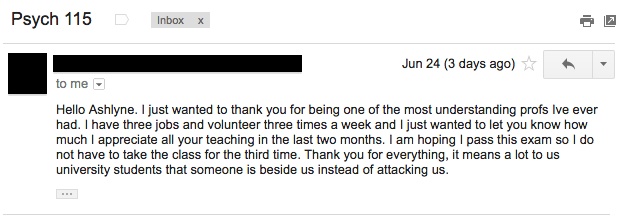
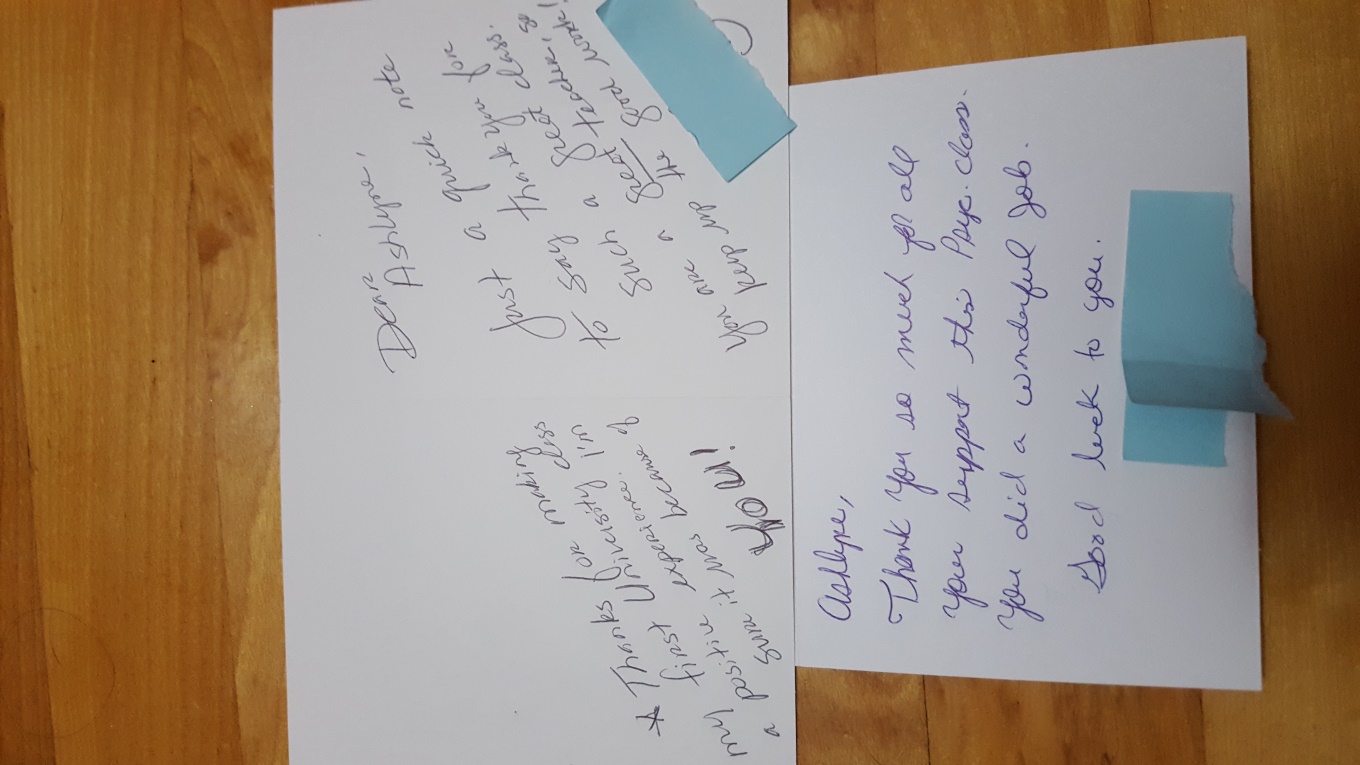
Appendix G: Solicited Feedback
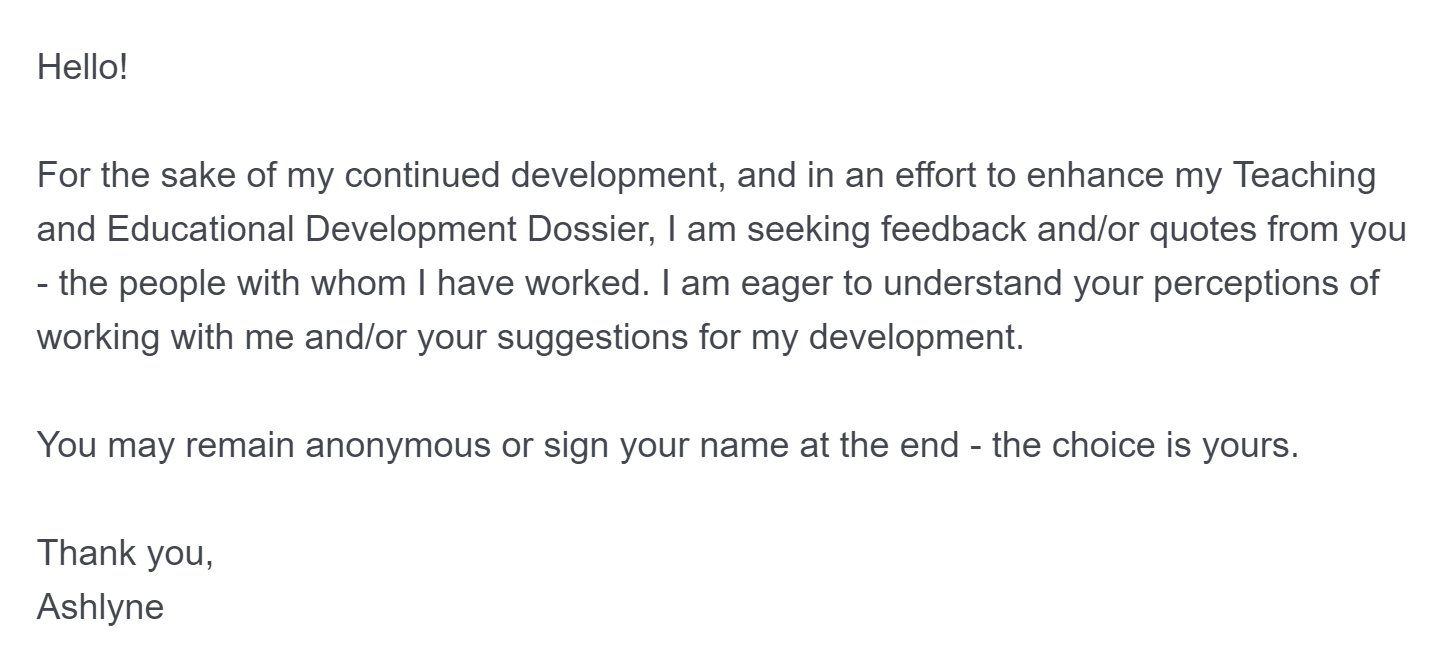 In June of 2019, a colleague of mine distributed an anonymous Qualtrics survey to a group of individuals with whom I have worked in various capacities. The survey text said the following:
In June of 2019, a colleague of mine distributed an anonymous Qualtrics survey to a group of individuals with whom I have worked in various capacities. The survey text said the following:
Selected quotes:
Nobuko Fujita, PhD Learning Specialist, Office of Open Learning
“[…] She is a good team player, with passion and commitment for supporting faculty, staff, and students in enhancing teaching and learning for individuals and groups at the University of Windsor. […] She shows creativity, patience, and persistence in learning new skills such as video production and post-production that help increase teacher presence and interactivity in the online course environment. […] Ashlyne is quick and thorough in providing feedback on areas in which she has expertise, such as in the design of online student evaluation of teaching (SET) survey that I prepared for my own online course, Exploring the Edges of Online Teaching. I really appreciated her comments and suggestions for improvement from both the Qualtrics tool and measurement perspectives. […]”
Michelle Bondy, Experiential Learning Specialist, School of the Environment and Faculty of Science
“[…] Her leadership is evident in all aspects of the program, including hiring, training and mentoring student leaders, promoting the programs to students and faculty, gaining Research Ethics Board approval to study the impact of PALS, and presenting on results so far at a recent conference. It is because of Ashlyne’s capabilities and dedication as the coordinator of this program that it will continue to grow on our campus, providing greater support to our students.”
E. Austin Mejia, PALS Leader (pilot)
“[…], she was always on top of the many tasks which she was responsible for. It was helpful knowing that she was there to support us as we ventured into the unknown […] She would go above our expectations and, for example, join in our first on-line sessions to ensure that everything was going smoothly, and we had backup if we needed it.”
Nicole Frowley, PALS Leader
“Working with Ashlyne has been a great experience. Not only is she passionate about her job she is also passionate about us (the leaders). She attends to all our needs and is constantly supportive. She is extremely approachable and easy to talk to.”
Laura Chittle, GATA Network Coordinator, CTL & Faculty of Graduate Studies
“[…] I have witnessed first-hand the passion and enthusiasm Ashlyne puts into her teaching […] She is scholarly in her approach to teaching, innovative, and always willing to work with new presenters and mentor them. Regardless of the workshop topic she is facilitating (e.g., leading discussions, grading and feedback) I can be confident that it will be intentionally designed to engage students, creative, and delivered with enthusiasm. Ashlyne consistently receives high rating from attendees at her workshops. Through developing and leading these workshops for GAs/TAs Ashlyne is enriching the educational experience of University of Windsor students and actively supporting the training of GAs/TAs from across campus. As a result, she is playing an active role in shaping and transforming the culture of teaching and learning at the University of Windsor.”
Anne Baird, PhD, Professor, Department of Psychology
“Ashlyne has been extraordinarily proactive and friendly in her work with me […] she has provided an astute orientation to the world of open learning; many excellent ideas at both the big-picture and detail level; and abundant curiosity, passion, and emotional support. It is apparent that she has assimilated and organized a lot of knowledge about open learning and honed many skills and that she goes beyond what is required to use and develop her gifts.”
Anonymous
“Ashlyne was a pleasure to work with, in my experience. On a large project, involving various professors, administrative staff, and students she did an excellent job maintaining order, communicating expectations and deadlines, and supporting people when they needed it. She was always easy to reach, quick to respond, and pleasant to work with. As someone who likes structure and certainty she made me feel comfortable in my role in the project, while also making me feel like a valued contributor.
The following are excerpts of letters previously obtained from a variety of faculty, colleagues, and students with whom I have worked in my capacity as a graduate student, teacher, and educational developer.
From Anoop Gupta, PhD, Sessional Instructor



From Jennifer Beneteau, undergraduate student
“[…] In Introductory Psychology, Ashlyne created an environment for class discussion and participation. She was kind and used humour to make students feel comfortable. I found that having an instructor who could relate to or make humour of relevant themes to be beneficial. To help facilitate learning, she provided additional resources such as crosswords to help define terms and prepare myself and other students for midterms and finals. In addition, she provided the opportunity for students to anonymously write down what they were struggling with and what they were 100% sure about. Ashlyne read through all the comments and addressed the struggles that students had.
For Social Science Research Methods, Ashlyne was my lab instructor and she did a great job engaging students and was very good at getting students to participate in activities and or conversations. For the lab section, Ashlyne created her own PowerPoint presentations from the ones she was given to use as a guide. Her presentations were much more organized and straightforward that the professor’s. They were easy to reference and use for class assignments. For our major assignment, as students we participated in our own research and gathered our own data. During this assignment she encouraged all of us to participate, engage and critically think about our assignment.
Having Ashlyne as a GA and instructor was very beneficial to my education at the University of Windsor. She was well organized in her lesson plans (written and spoken), a great speaker and easy to understand, thorough in her explanations and excellent at making connections between the material and real life. She looked comfortable speaking in front of the class and was able to keep students and myself engaged in the lesson. Ashlyne is a great instructor and enhanced/deepened my learning through each experience. I highly recommend her to receive the GA Award for Educational Practice, and cannot think of anyone more deserving. […]”
From Natalie Lewoc, undergraduate student
“[…] Ashlyne effectively enhanced, maximized, and deepened my learning in Educational Psychology. One way in which she accomplished this was by motivating and challenging me to refine my writing, whilst maintaining integrity and a caring attitude as a teacher. After a misunderstanding with a professor led to a low mark on the first assessment, I met with Ashlyne to discuss how I could improve my work. She was very understanding of my concerns, noted my strengths, and gave me advice as to how I could better integrate psychological concepts with my own comments and ideas. Upon being offered an opportunity to resubmit, I used her feedback to transform my assignment and in doing so, immensely boosted my grade. Beyond percentages, I had also grown as an individual. It is these kinds of encounters with GA’s and TA’s that produce lasting positive effects on students in both their academic and personal lives.
I further contend that Ashlyne’s excellent use of scholarly and learning-centered strategies, methods, techniques, and learning experiences qualify her as worthy of receiving this award. During her guest lecture on classroom assessment, Ashlyne swiftly created a safe environment for open discussion regarding the pros and cons of assessment in the educational context, prompting us to think critically about the content being presented. The stories of personal experiences with good and bad assessments that she incorporated into her presentation gave an element of sincerity that captured and sustained our attention, ultimately facilitating our deep learning of the material. Illustrative of the effort that she had put into her lecture, Ashlyne had even prepared a “develop your own assessment plan” activity, allowing us to put our knowledge to use. These instances of dedication and passion towards teaching situate Ashlyne as a nominee who not only meets the criteria for the GA and TA Award for Educational Practice, but also surpasses them in many respects. […]”
From Michelle Krieger, MA, PhD Candidate
“[…] During class time, Ashlyne routinely builds in opportunities for students to engage with the material and practice what they have learned. For example, in her guest lecture for Introduction to Psychology as a Social Science on applied social psychology, Ashlyne included discussion questions reviewing key concepts and relating them to what the students had already learned about social psychology. She also included a group activity in which students: identified a potential problem to be addressed using applied social psychology; described various factors related to their example; and discussed their ultimate goals for addressing the problem. She further promoted deeper learning by using real life examples relevant to the students; for example, bridging the gap between understanding and application was illustrated using the bystander effect and the Bystander Initiative on the University of Windsor campus. This is one example of active learning techniques that Ashlyne regularly uses in order to enhance students’ learning experiences.
Ashlyne also consistently uses learning-centred assessment and feedback strategies. This is best exemplified by the assessment tasks and feedback opportunities used when she taught Introduction to Psychology as a Behavioural Science. All of the assessment tasks were thoughtfully designed to be consistent with the overall course objectives and the learning experiences. For example, the main writing assignment in the course was scaffolded, building on an earlier in-class writing assignment which had students apply the course material to their own lives. Ashlyne provided students with formative feedback on this task (and throughout the semester), helping students work towards achieving the learning objectives. […]”
 From Laszlo A. Erdodi, PhD, Associate Professor
From Laszlo A. Erdodi, PhD, Associate Professor
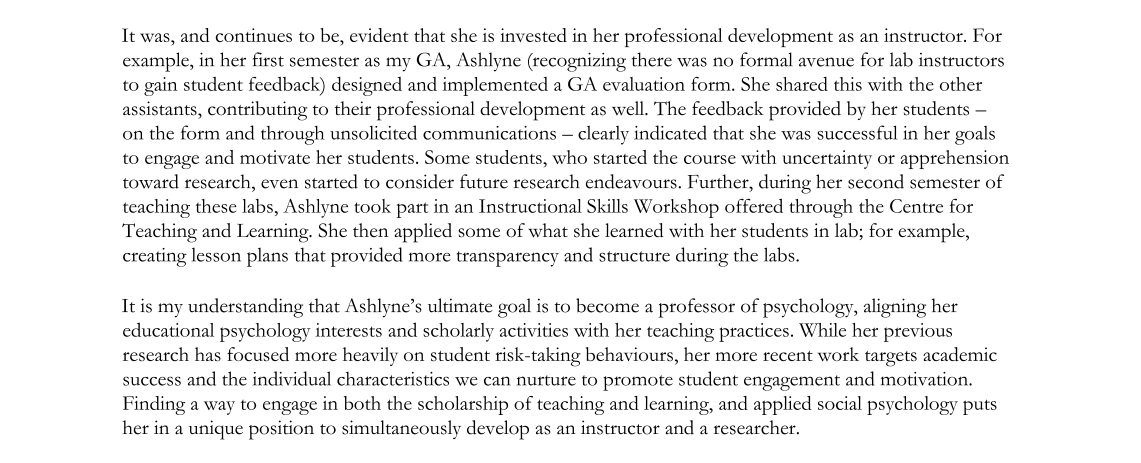
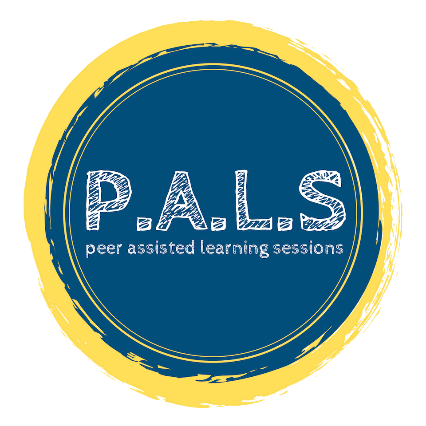 Appendix H: Promotional Materials for PALS
Appendix H: Promotional Materials for PALS
I created this logo for the PALS program in order to develop a brand and enhance our promotional materials. Using blue and gold helps identify the program as part of the University of Windsor; the circles represent continuous learning at various levels within the institution and students’ lives; and the scribbled text and messy edges are meant to communicate the unfinished nature of our work.
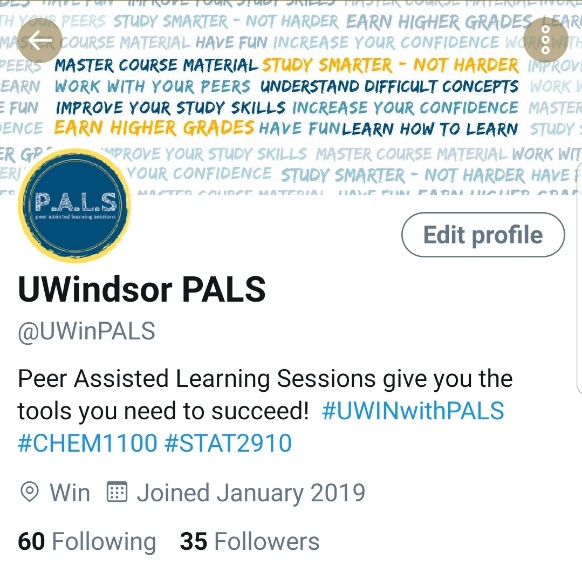 I also created a Twitter account to promote PALS more generally on the web, to enhance our network of practitioners, and to reach students through social media: https://twitter.com/UWinPALS
I also created a Twitter account to promote PALS more generally on the web, to enhance our network of practitioners, and to reach students through social media: https://twitter.com/UWinPALS
Unfortunately, we haven’t been able to reach as many students as I thought we could through this avenue, but we have made some good connections with similar programs at other institutions, and with faculty and educational developers interested in the program. I hope that with continued promotion and program growth, that eventually Twitter will have a greater impact. An example of such an approach has been used at the University of Guelph (@SI_CDN) who posts to their page regularly and makes it a key form of communication with their students.
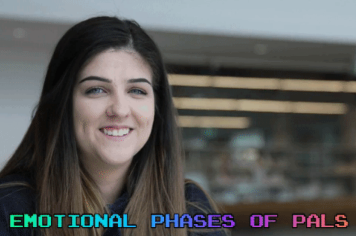
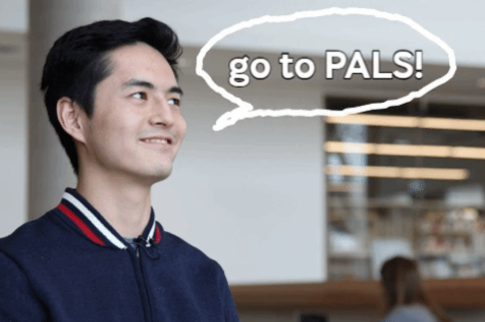 These are GIFs I created to promote PALS on Twitter. Because Word does not support animations, I have included still shots to illustrate their purpose. The first was of PALS Leader, Chris, with an animated speech bubble telling students to go to PALS! The next was another Leader, Nicole, making a series of faces depicting various emotions. The photos were candid shots I took during an interview with her, but I got the idea to make a GIF after observing students in one of her sessions navigate through many thoughts and feelings while learning their course content. At first, they were apprehensive about engaging with the session, but by the end they developed the courage to offer their own participation without being asked, getting up to the board and taking the lead for themselves. At one point, I heard a student have an “aha” moment, which is one of the most rewarding things about facilitating sessions like these.
These are GIFs I created to promote PALS on Twitter. Because Word does not support animations, I have included still shots to illustrate their purpose. The first was of PALS Leader, Chris, with an animated speech bubble telling students to go to PALS! The next was another Leader, Nicole, making a series of faces depicting various emotions. The photos were candid shots I took during an interview with her, but I got the idea to make a GIF after observing students in one of her sessions navigate through many thoughts and feelings while learning their course content. At first, they were apprehensive about engaging with the session, but by the end they developed the courage to offer their own participation without being asked, getting up to the board and taking the lead for themselves. At one point, I heard a student have an “aha” moment, which is one of the most rewarding things about facilitating sessions like these.
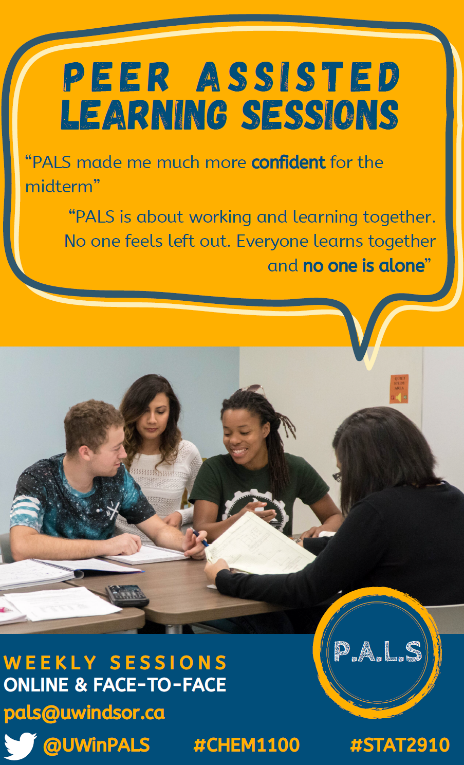 These are samples of the posters I created to hang around campus and post online. I concentrated the posters in buildings and near classrooms where students enrolled in the associated courses go. I also make a point to attach one to a Blackboard announcement once in a while, in order to grab students attention visually. (I should also note that I altered the yellow to a more orange hue because they were initially printing green)
These are samples of the posters I created to hang around campus and post online. I concentrated the posters in buildings and near classrooms where students enrolled in the associated courses go. I also make a point to attach one to a Blackboard announcement once in a while, in order to grab students attention visually. (I should also note that I altered the yellow to a more orange hue because they were initially printing green)
While all posters are meant to promote the PALS program and remind students of the sessions, each has been designed for a specific reason. The poster to the left includes two quotes from previous PALS students and a photo of students engaged in collaborative learning, to demonstrate the supportive atmosphere. The poster with the text background was meant to be more visually appealing and grab students’ attention. It was also scattered around Essex Hall and the new CoRE building where the sessions are located. The third poster included here shows a picture I took during a staged mock session, the program name displayed prominently, and the schedule for the specific course, communicating more details to the students.
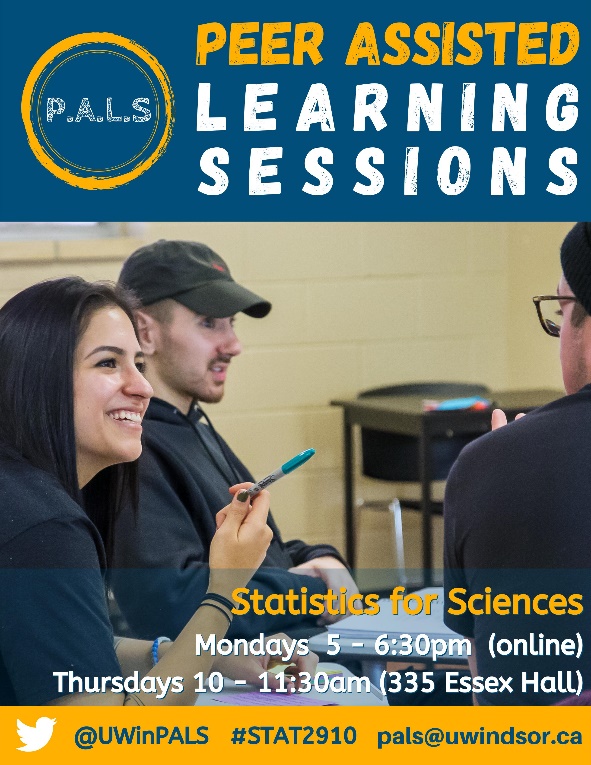
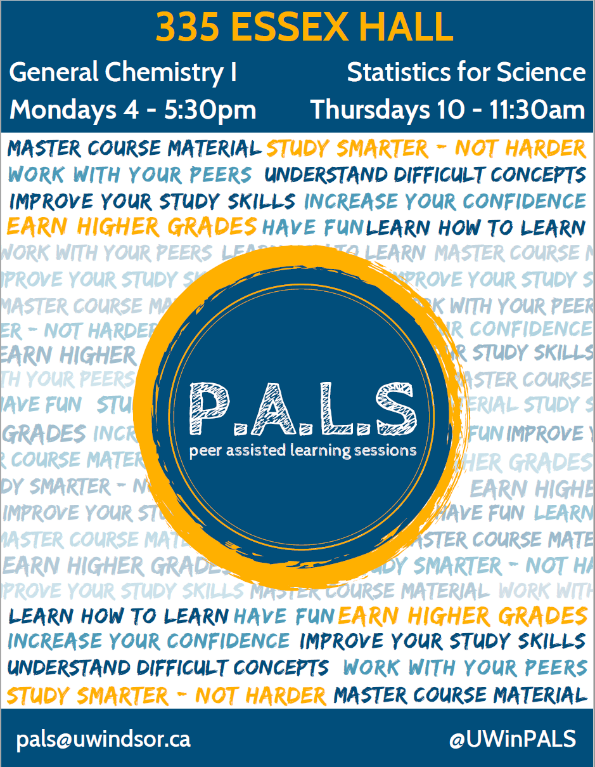
Finally, with the help of our media interns, we have created three versions of promotional videos that have been posted on Twitter and Blackboard, and used to introduce faculty, staff, and administrators to the program. The first was a brief 2-minute video created before the program even started. The second was 5 minutes long and provided a lot of information about the program, including a student testimonial. However, the music was a bit loud, and the video seems a bit too long: https://youtu.be/fRXOD1GSyFQ. The following, updated, video was created this year: https://youtu.be/296X5m6WlBw.
Appendix I: Sample Course Resources

This is a screenshot of a lightboard video – one in a series of over 20 – that I filmed with an economics instructor. This was an excellent experience, and one of my first as a video producer in the educational context. I was able to witness the pedagogical development of this instructor over the course of a year, and his initial apprehension turn to pure excitement and motivation to help his students and create meaningful learning aids like these lightboard videos.
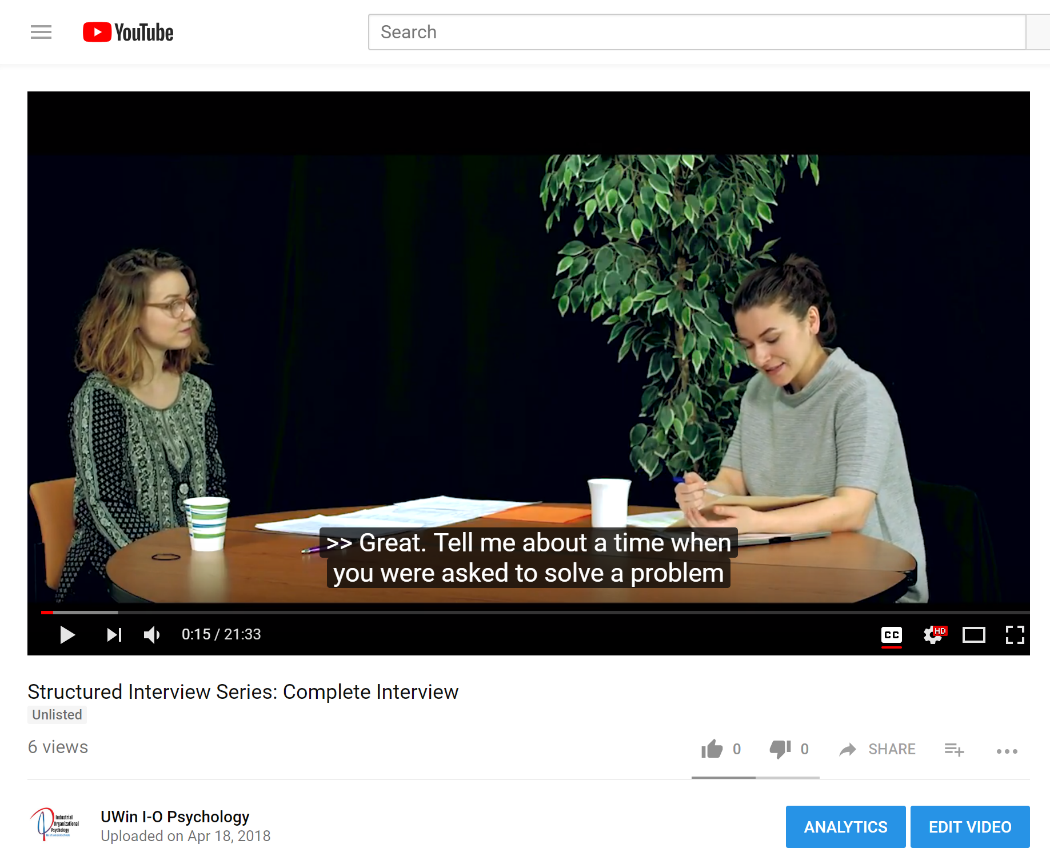
This is a screenshot of an interview video created for a talent management course where students must learn proper techniques for structured behavioural interviews and identify potential dilemmas associated with other interview practices. I was responsible for the coordination of the casting and filming (scattered over four days), and supported the content-expert in his creation of the script. I was also heavily involved in the post-production of these videos, which are currently “unlisted” on YouTube, but can be found at the following links (selected sample):
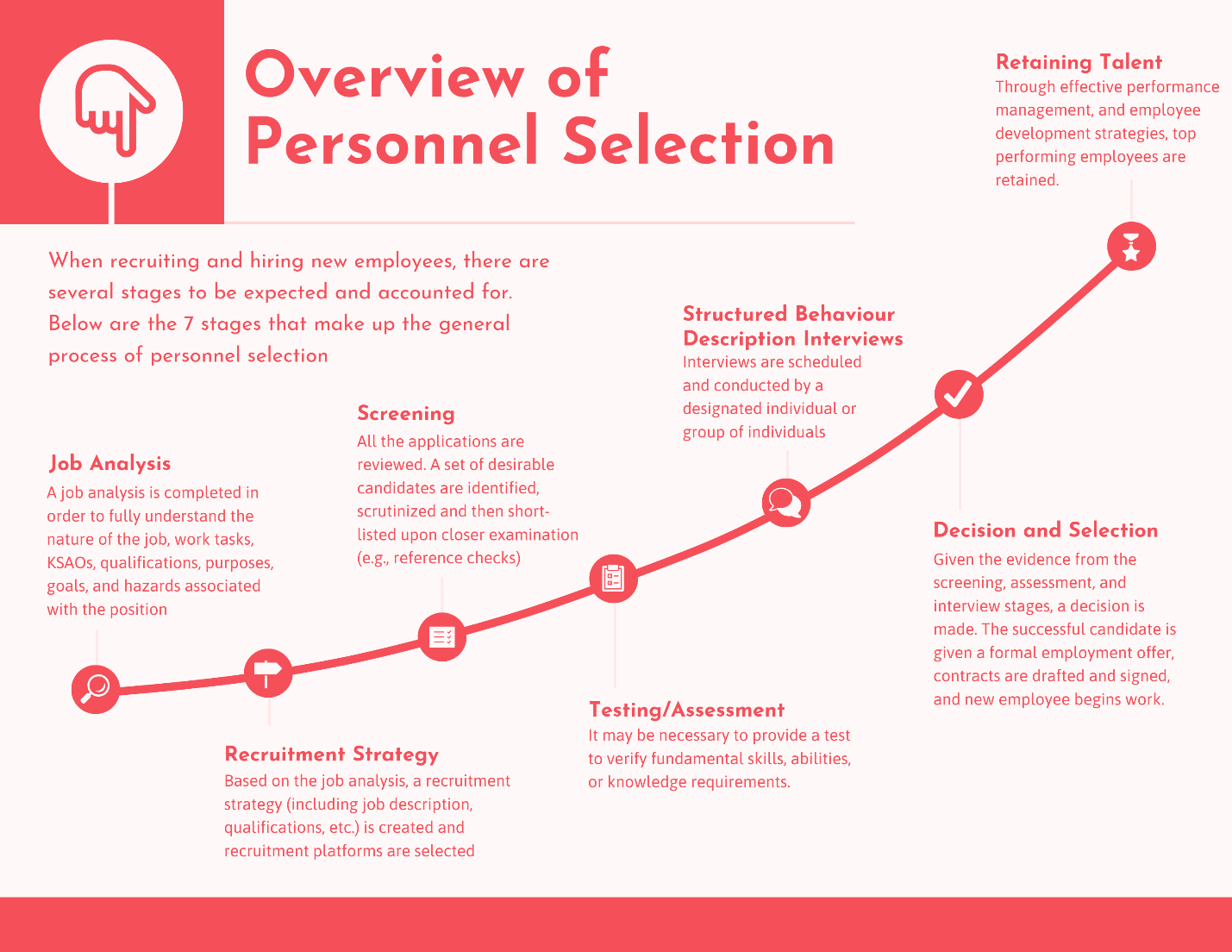 The above image is an infographic I created for the Foundations of Industrial-Organizational Psychology course, and illustrates the general process of personnel selection.
The above image is an infographic I created for the Foundations of Industrial-Organizational Psychology course, and illustrates the general process of personnel selection.
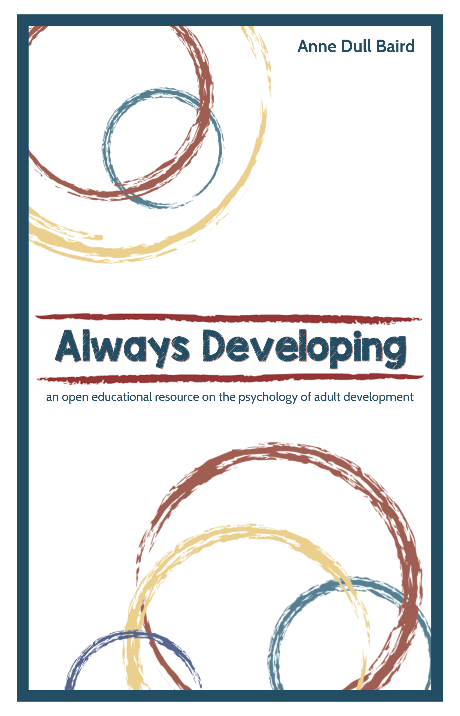
This is a small image of the cover I designed for an open text about adult aging. The circles represent the continued development through the lifespan, and I chose the colours based on accessibility and visual appeal. The instructor for the course really liked this design, and even though it was initially supposed to be a ‘mock-up’ we ended up using it.
This cover was created based on the PowerPoint theme and template I had created for the same project at an earlier date. Examples of the various types of slides (title, content, image) can be seen on the following page.
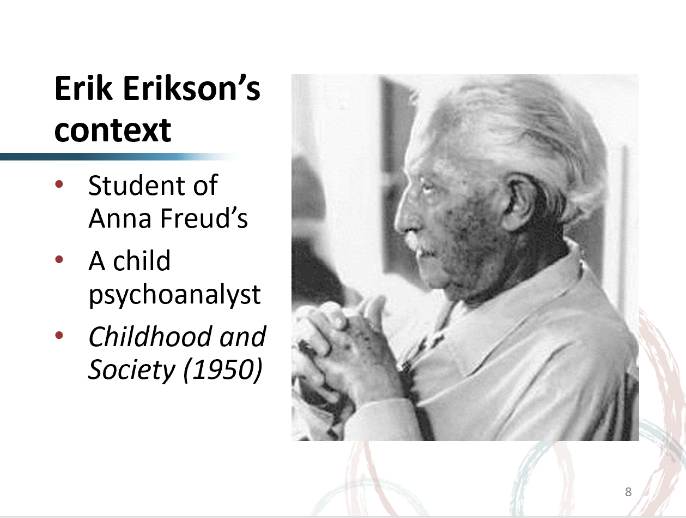
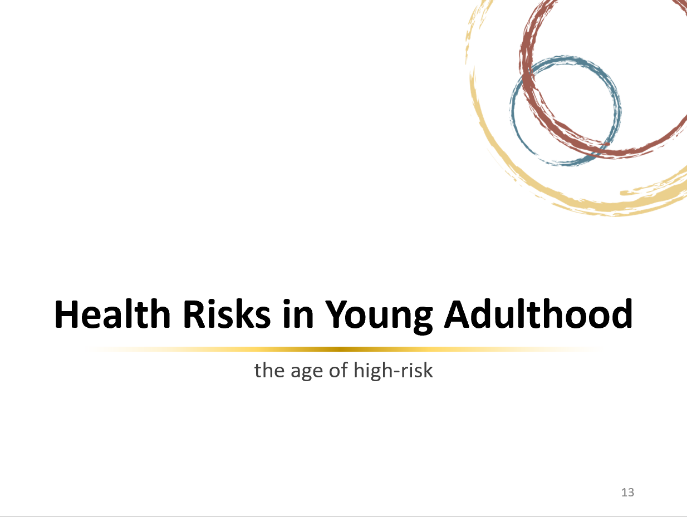
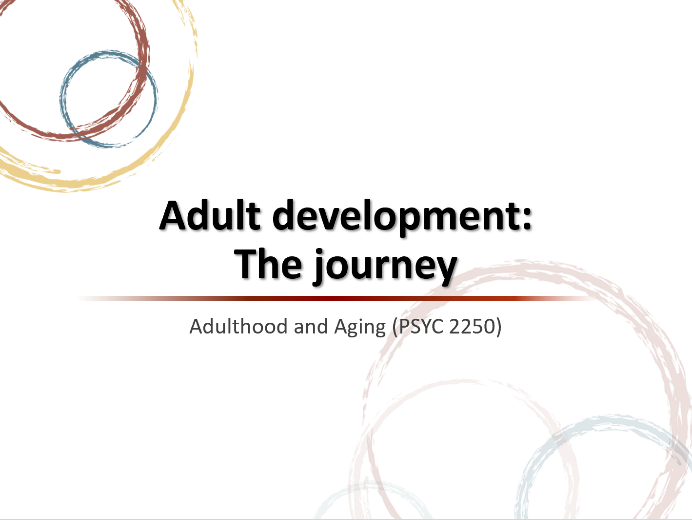
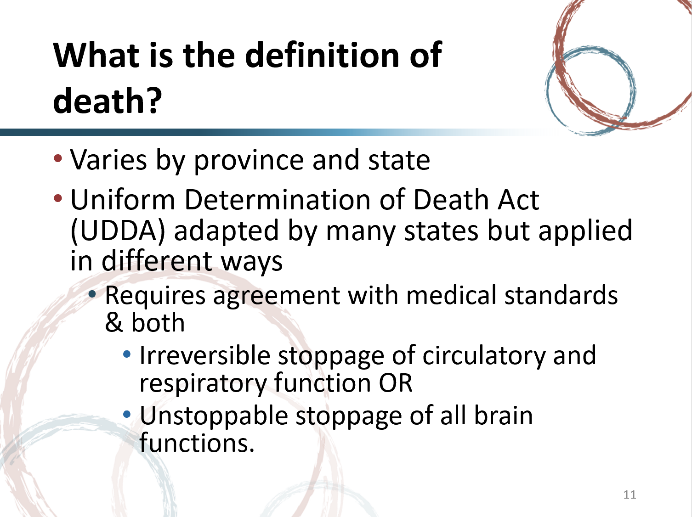
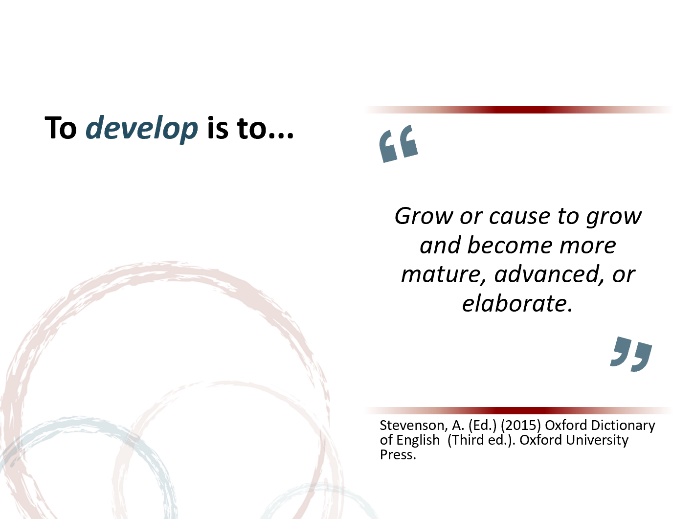
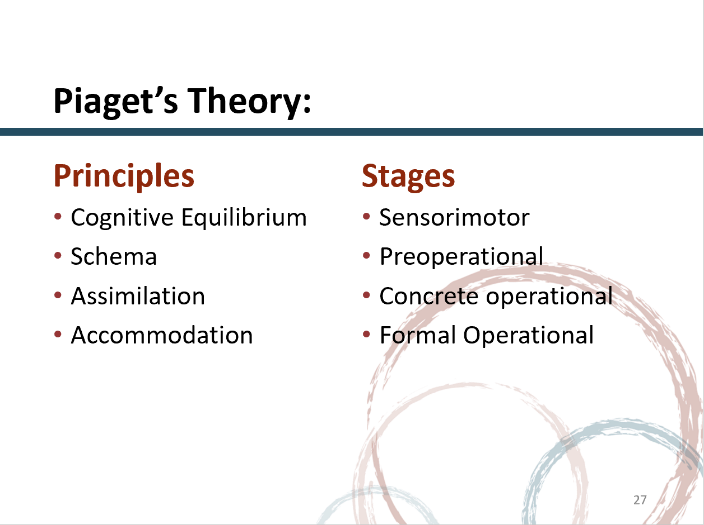
Appendix J: Course Sketch Template
Course Sketch Report
___ Edition
Course Name
Instructor Name(s)

Completed by ___________
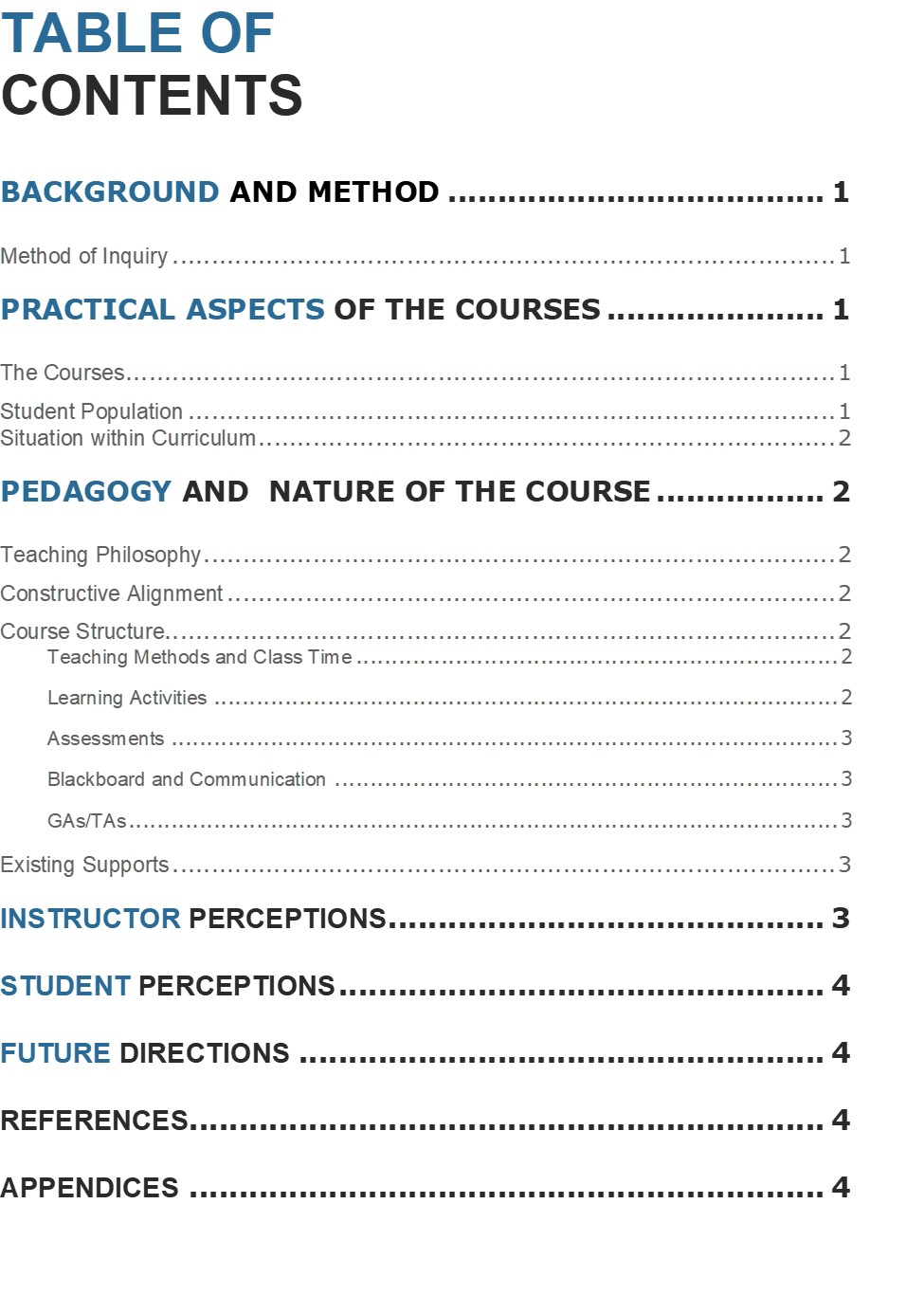
This course sketch provides insight into the instructor’s pedagogical approach, the nature of the courses and their components, course-related perceptions, the student population, and student performance.
Describe any questions guiding the inquiry, as well as the methodological perspective.
Below are the types of data that may be used. Consult the case study report for details on how each may contribute to the investigation and analysis.
Course Syllabi
Syllabi from Other Courses
Undergraduate Course Calendars
Semi-structured Interview
Instructor Teaching Philosophy
Student Evaluations of Teaching
Course Performance
Student Information System (SIS)
Attendance Records
Analytics on Video Tutorials
Surveys
Focus Groups
Practical Aspects
Of the courses
Describe the courses how they appear to the students, using information from the course calendars and syllabi.
Describe the nature of the students in the course using data from SIS.
Use the course calendars and SIS data to identify the curricular demands on students (i.e., what other courses they are taking at the same time).
Pedagogy and
Nature of the COurse
To fully understand a course, the constructive alignment, approach to teaching, learning activities, and assessments must all be considered.
Highlight the ways in which the teaching philosophy is most related to the course.
Outline the learning outcomes, teaching methods, learning activities, and assessments of the course, demonstrating how they are or are not aligned.
You may choose to use a diagram to represent the relationships between each.
Teaching Methods and Class Time
Describe how the instructor uses class time, and what the typical student experience would look like in class.
List and describe each of the types of learning activities that are expected of students – both within and outside of class time.
Some examples might include:
Reading the textbook or other material
Practice problems, homework, or online quizzes
Tutorials, labs, supplemental instruction, video tutorials
Activities and demonstrations within class
Discussion, debate, reflection
And many more…
If surveys or focus groups are part of your methodology, you may want to include how students actually engage with each type of learning activity, in comparison to the instructor’s intentions.
Breakdown the components of each assessment method, and how each contributes to the overall course grade
Blackboard and Communication
Explain the instructor’s policies and practices surrounding communication and use of the learning management system
What are the roles of graduate and teaching assistants, and how many are usually involved in the course?
Transitional Supports
Especially for introductory courses, there may be some transitional supports in place – or not.
Office Hours & Open Door
Explain the instructor’s policy for office hours, etc.
It may also be pertinent to describe how office hours are typically run, how many students attend, and the concerns that are often brought forward.
As evident throughout this report, the instructor’s perspective is integral for understanding the true nature of these courses, and how they are experienced by all parties involved.
Indicate how the instructor perceives the population of the course, and the relationships they foster with students. How do they believe this impacts the course?
Also describe the following from the instructor’s perspective:
Level of engagement
Student success
What do the students most enjoy about the course?
What do the students typically struggle with?
When and how are at-risk students identified?
Indicate how the instructor perceives the course itself.
What has been working well?
What are some challenges in teaching this course?
STUDENT PERCEPTIONS
Using information such as that from student evaluations of teaching, Rate My Professor, surveys, and focus groups, document students’ perceptions of both the instructor, and the course.
It may be pertinent to highlight patterns in SET scores over time, or over certain items.
FUTURE DIRECTIONS
Highlight any plans for the future, including refinement measures, interventions, or plans for inquiry.
Include any references that you may have used in the report.
Include any appendices such as the teaching philosophy at the end.
If you complete multiple versions of the course sketch over time, and as you implement refinement measures or interventions, highlight the changes in a table.
Appendix K: Course Redesign Inquiry Framework
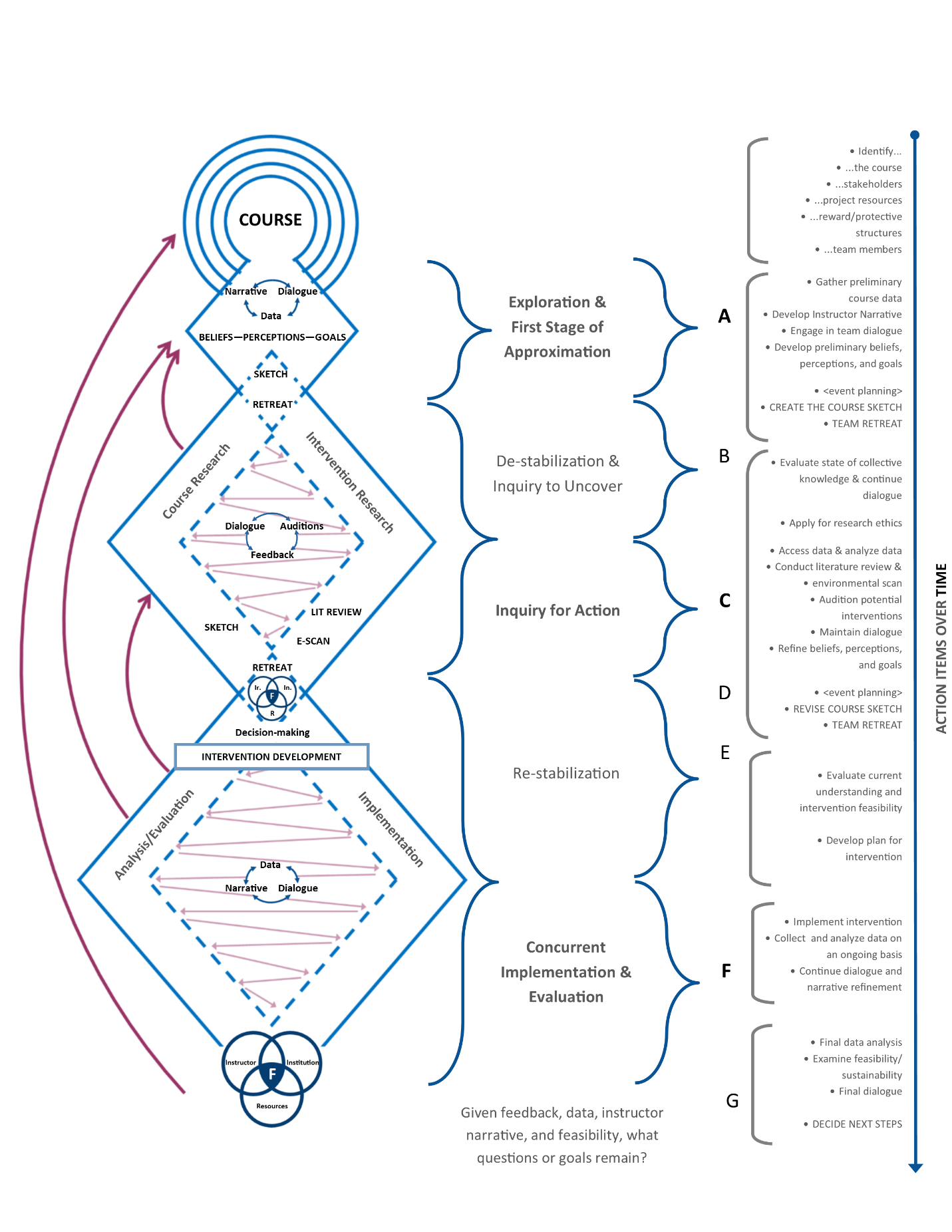
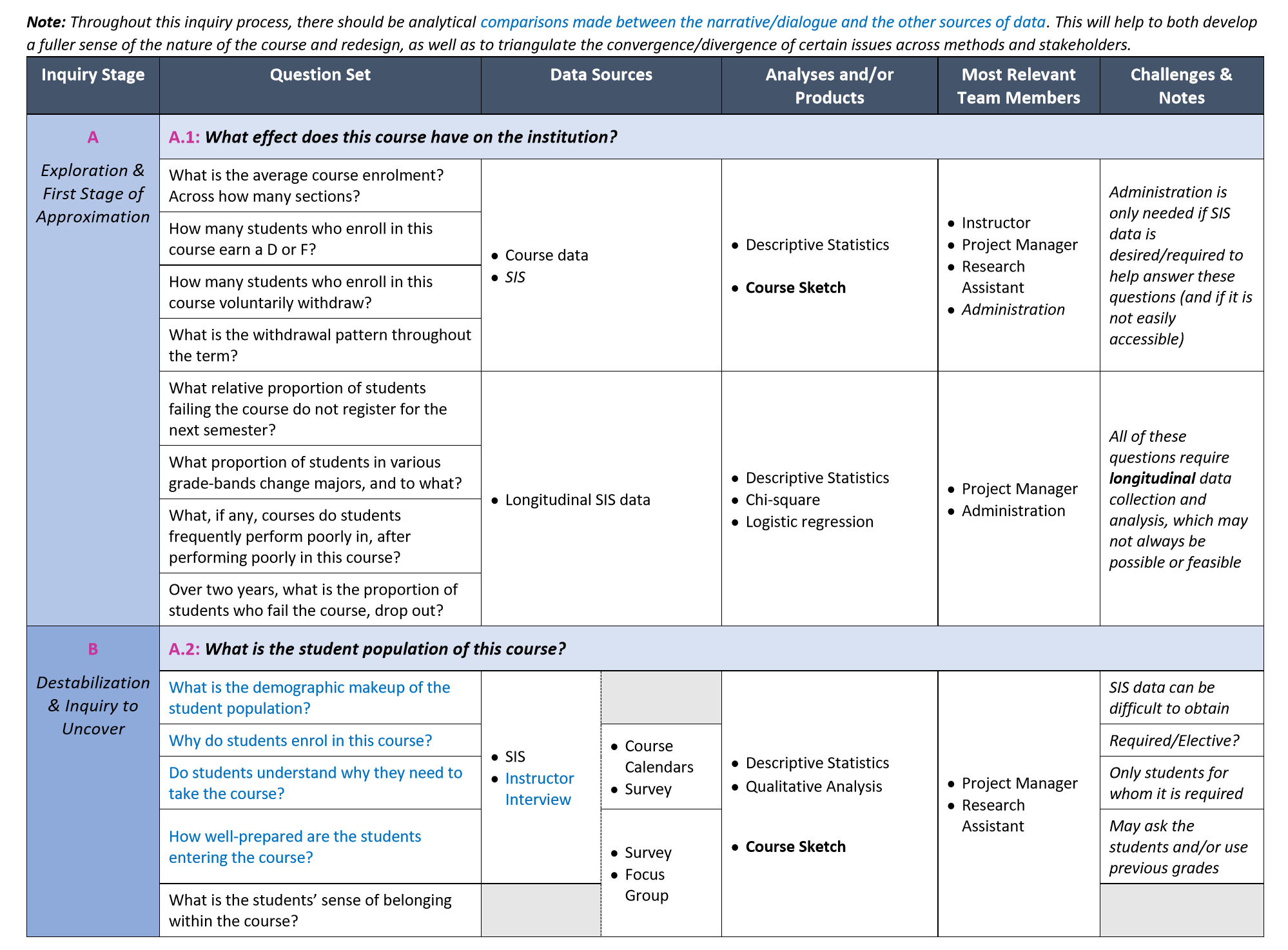
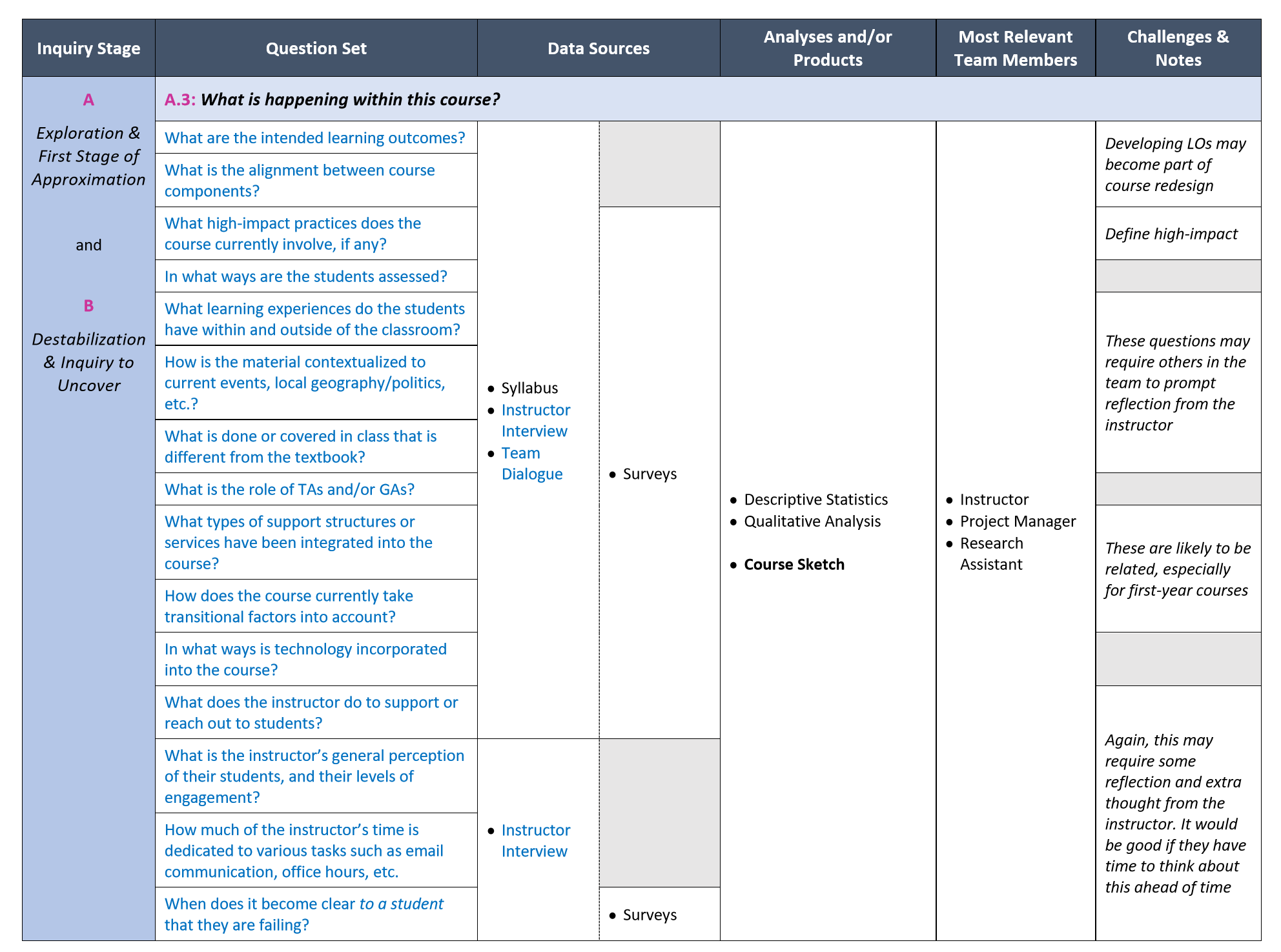
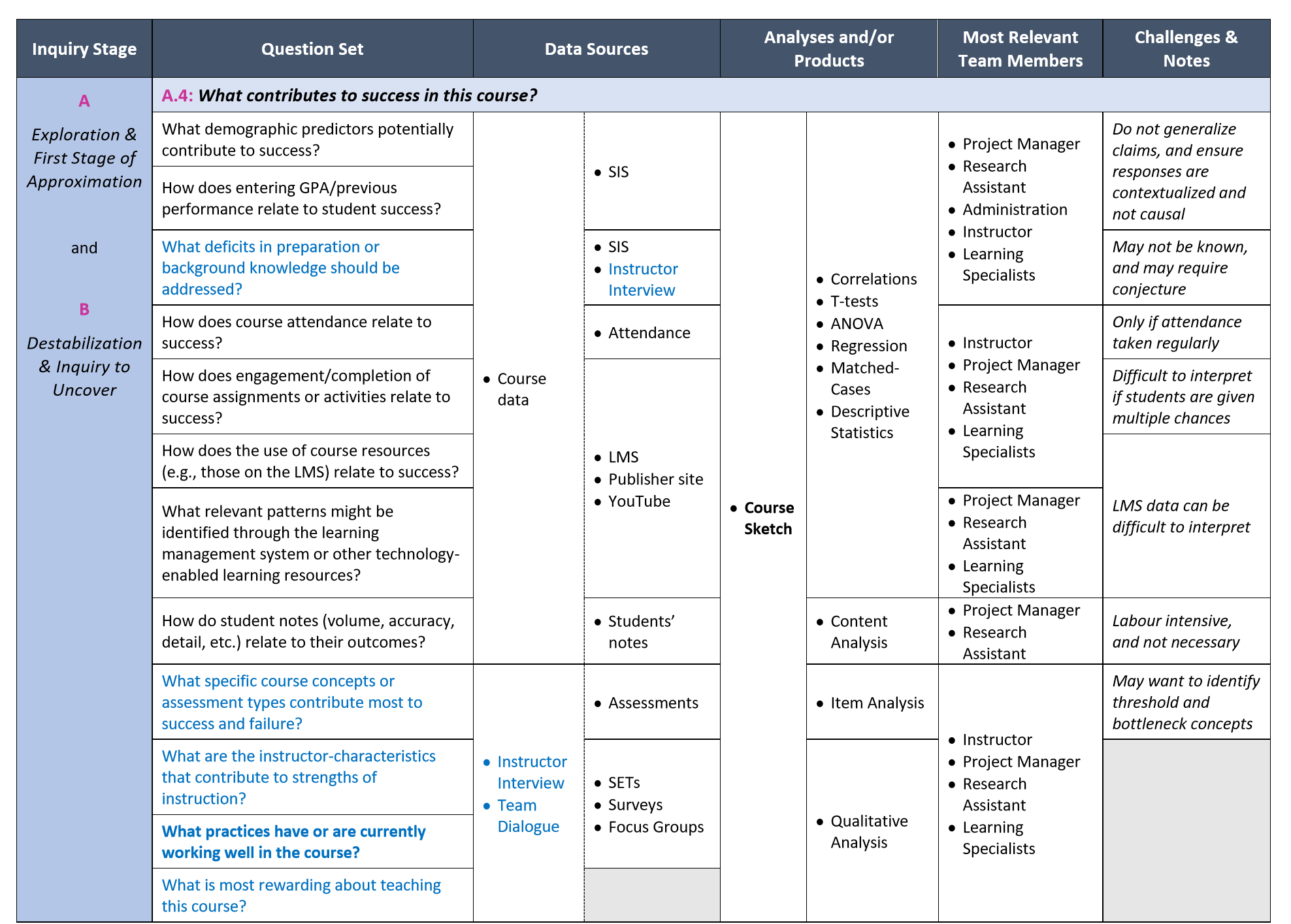
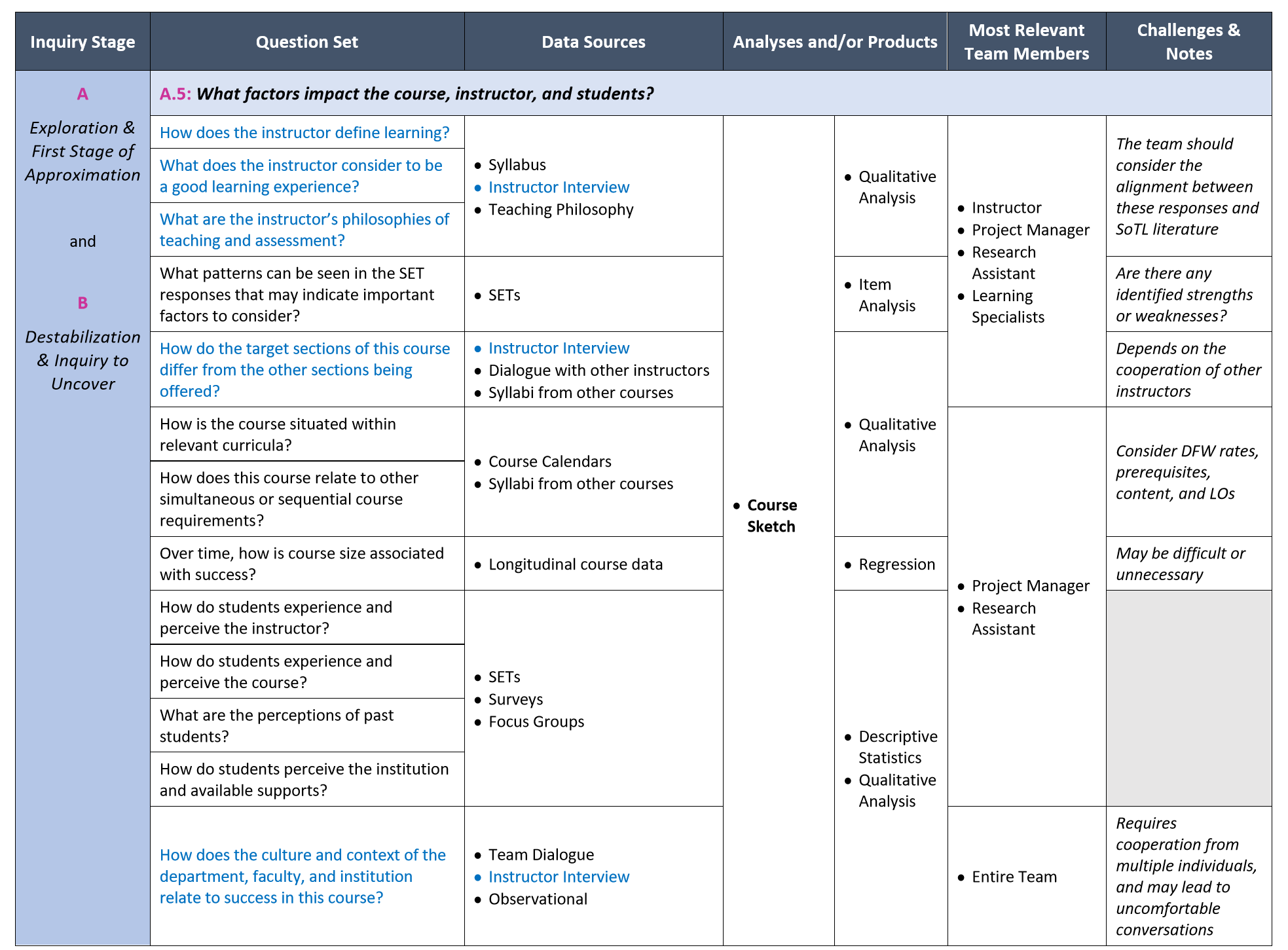
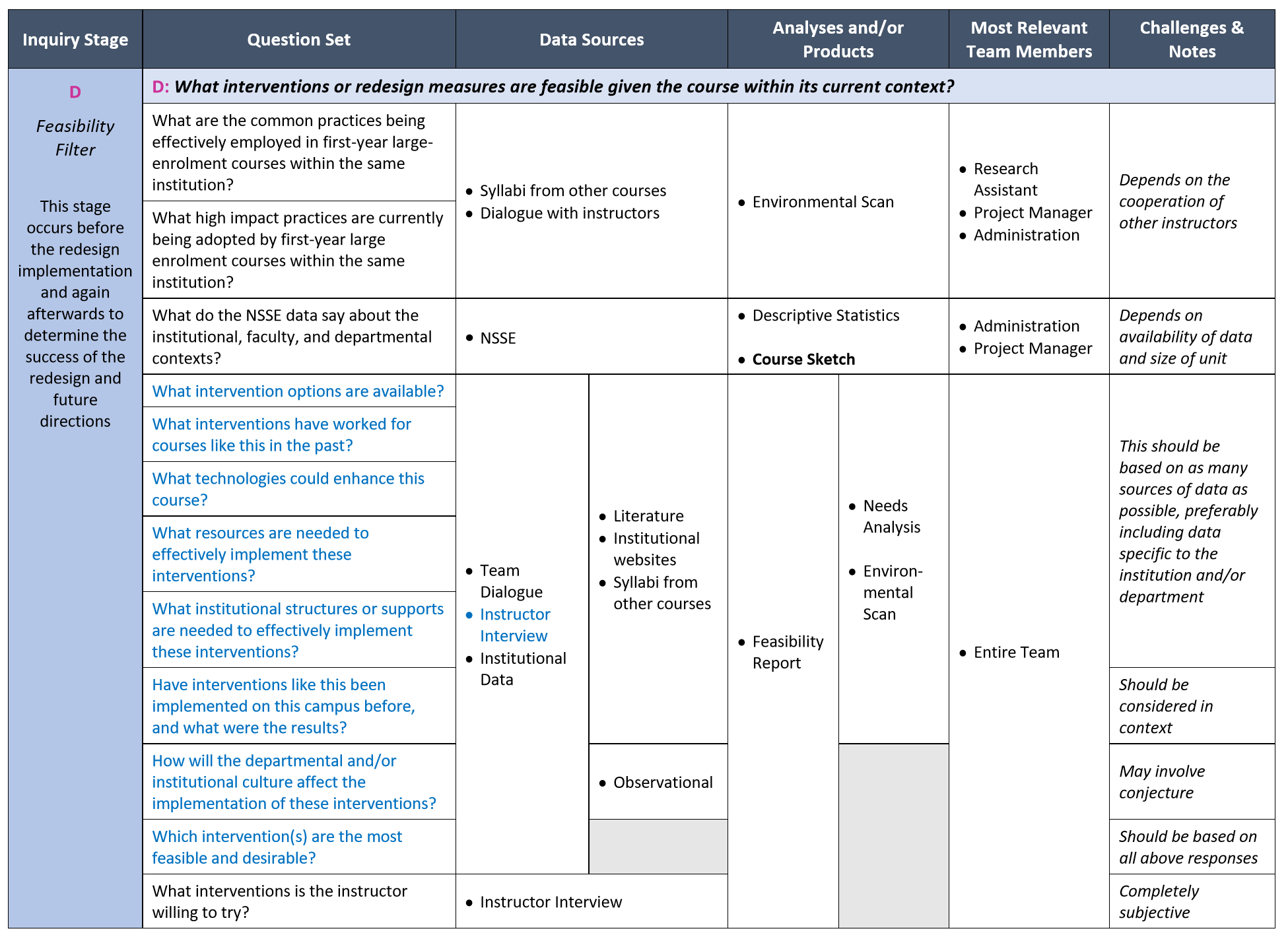
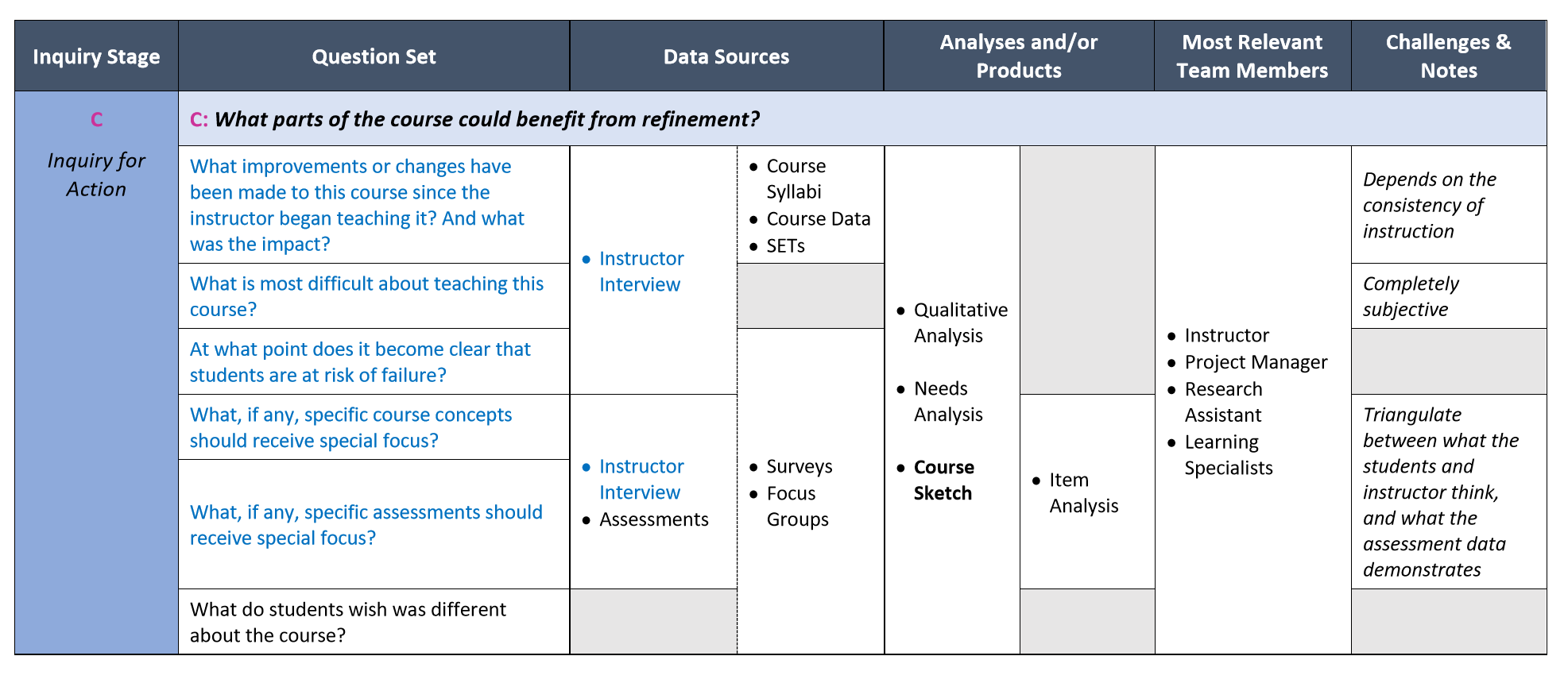
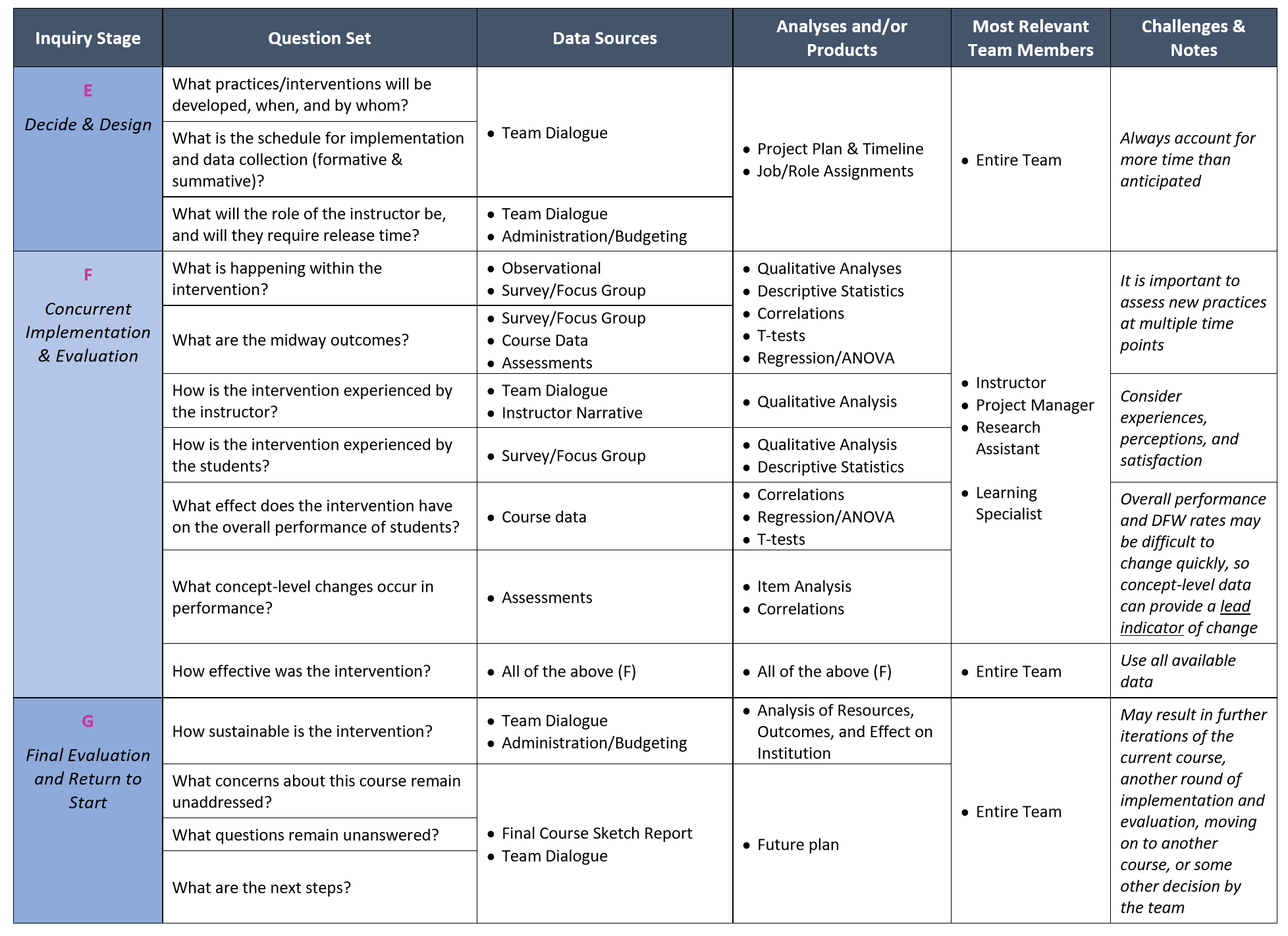
Appendix L: Relevant Certificates
